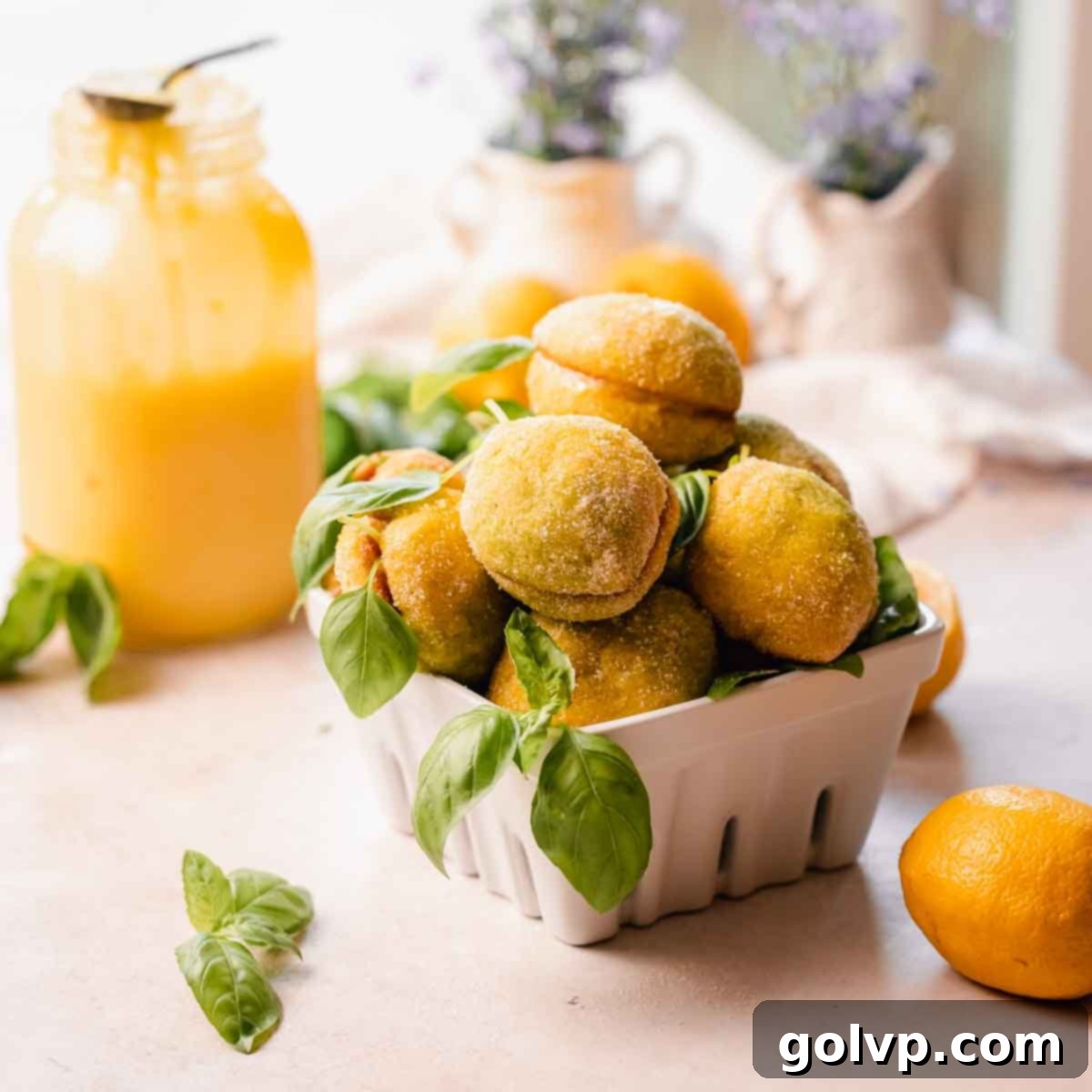Exquisite Italian Lemon Olive Oil Cookies with Zesty Lemon Curd & Basil Limoncello Syrup
Experience a truly unique and delightful dessert with these extraordinary Italian Lemon Olive Oil Cookies. Far from your average treat, these cookies stand out with their intricate flavors and charming appearance. Each cookie is a masterpiece, featuring a soft, cake-like olive oil lemon base, generously filled with a tangy, luscious lemon curd, and then dipped in a fragrant lemon basil syrup infused with a hint of limoncello. This thoughtful combination of earthy olive oil, bright zesty lemon, and aromatic basil creates a symphony of flavors that will captivate your palate and leave a lasting impression. Inspired by the classic Italian peach wedding cookies, they are meticulously shaped like miniature lemons, making them an ideal, individually portioned dessert for any special occasion or celebration. Prepare to impress your guests, as these cookies are truly a showstopper!
For more delightful lemon curd cookie creations, be sure to try my lemon curd thumbprint cookies.
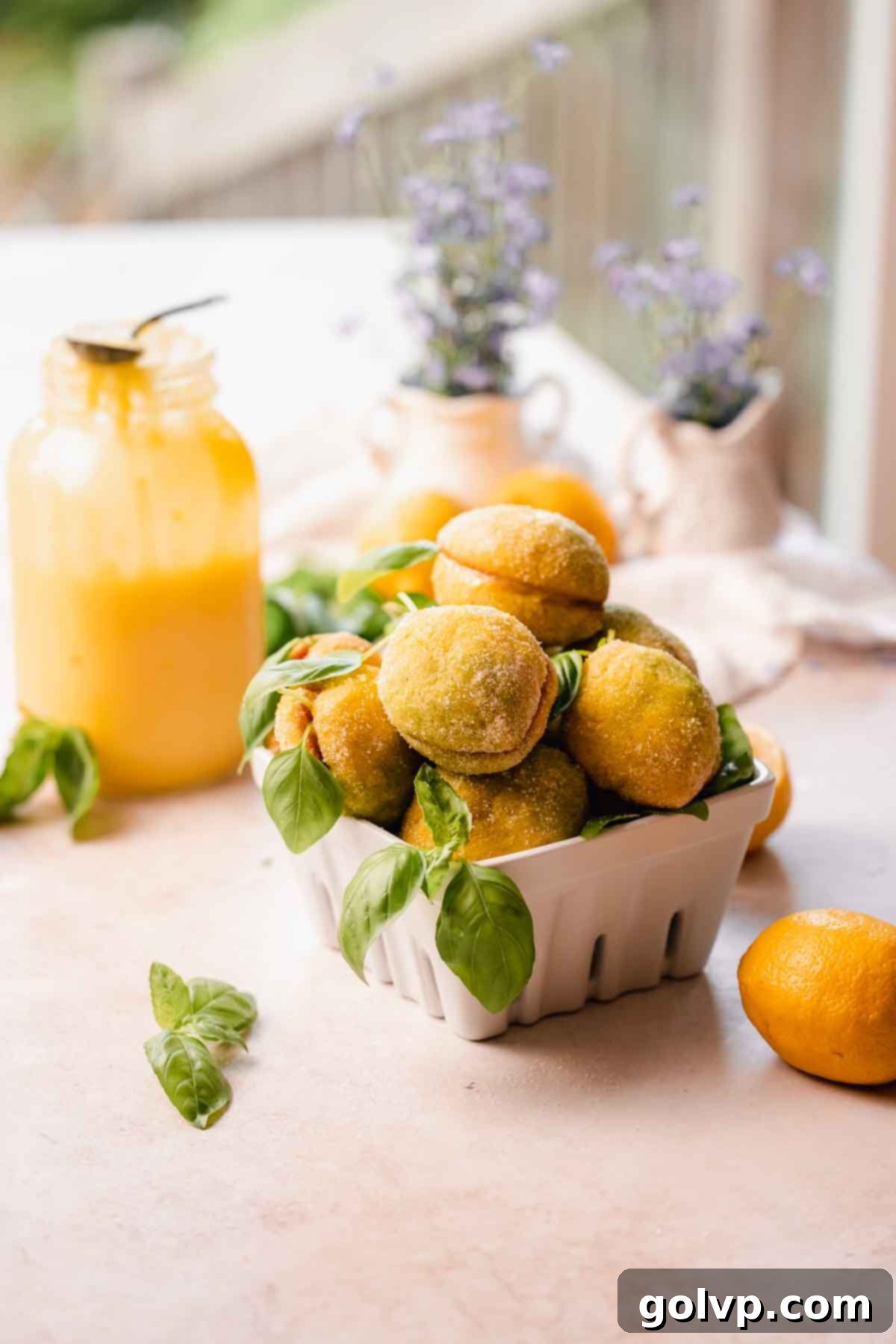
🍋 Why You’ll Adore This Italian Lemon Cookie Recipe
- Lemon Olive Oil Cookies: The foundation of this incredible dessert is a cookie dough that perfectly balances the bright, zesty notes of fresh lemon with the subtle, earthy richness of olive oil. Unlike traditional butter-based cookies, the olive oil lends a unique tenderness and a sophisticated depth of flavor, making these cookies incredibly moist and wonderfully aromatic. It’s a combination that truly elevates the humble cookie to something extraordinary.
- Lemon Curd Filling: Prepare for a delightful surprise with every bite! Nestled within the soft cookie is a generous center filled with tangy, gooey, and silky-smooth lemon curd. This vibrant filling bursts with intense lemon flavor, providing a delicious contrast to the subtly sweet cookie dough and adding an irresistible moistness. It’s the perfect lemony heart that makes these cookies so special.
- Soft, Cake-Like Texture: These aren’t your crisp, crunchy cookies. Instead, they boast a wonderfully soft, almost cake-like consistency that melts in your mouth. Their tender crumb makes them feel more like delicate individual pastries, offering a comforting and luxurious eating experience. The texture perfectly complements the creamy filling and syrup.
- Limoncello Basil Syrup: The magic continues as each cookie is delicately dipped in a fragrant syrup, bursting with lemon and infused with fresh basil, then finished with a touch of authentic Italian limoncello. This triple-threat syrup not only adds another layer of bright citrus and subtle herby flavor but also ensures the cookies remain incredibly soft and moist for days, transforming them into truly irresistible treats. The limoncello contributes a deep, complex lemon aroma without being overly alcoholic.
- Visually Stunning & Unique: Beyond their incredible taste, these cookies are a feast for the eyes. Their unique lemon shape, vibrant yellow and green coloring, and fresh basil “leaves” make them visually striking. They are a conversation starter and a guaranteed showstopper on any dessert table, reflecting the artistry of Italian confectionery.
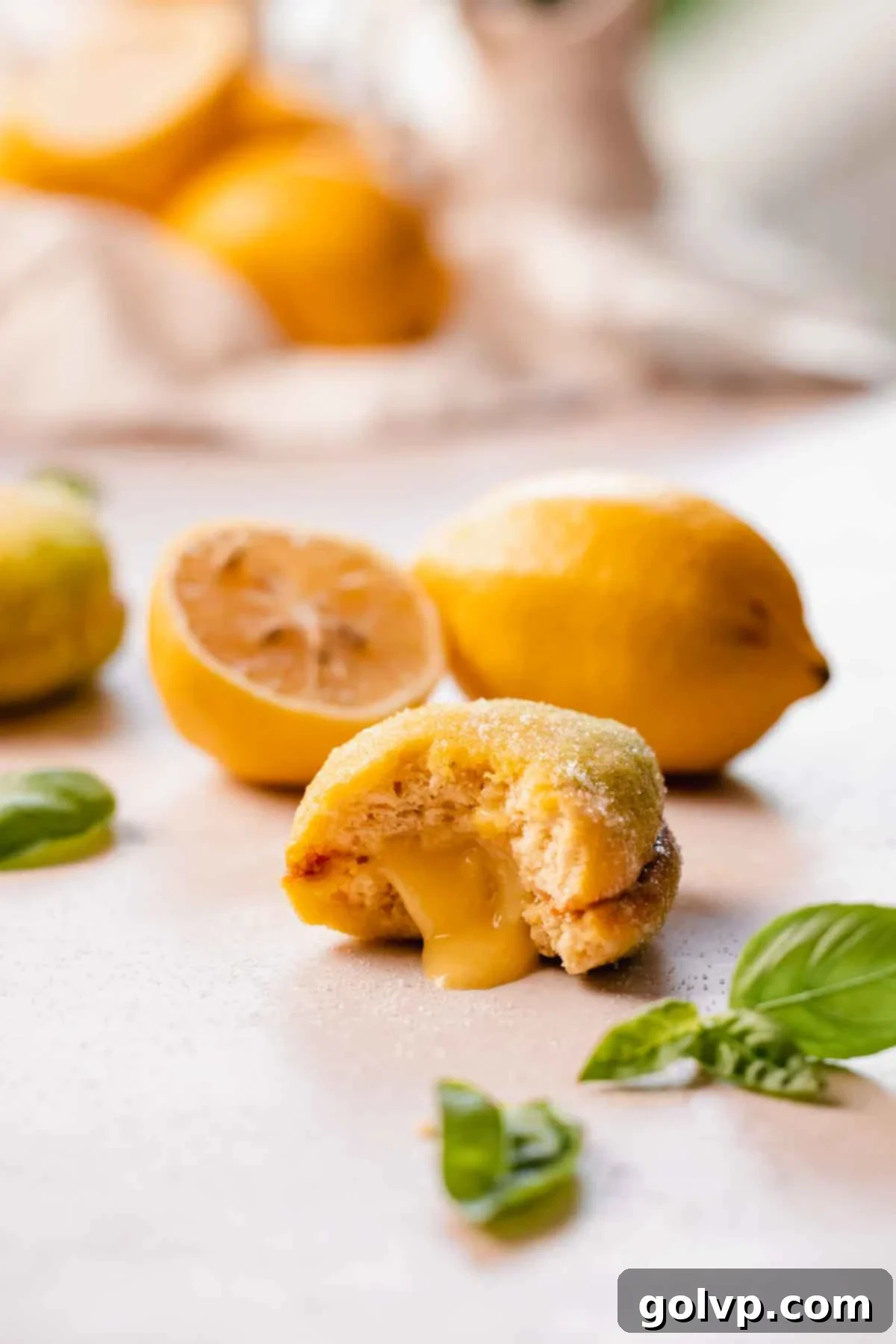
📝 Essential Ingredients for Authentic Italian Lemon Cookies
Mastering this recipe starts with understanding your ingredients. Below are key tips for selecting and preparing each component.
Full steps and ingredients with precise measurements are detailed in the recipe card further below.
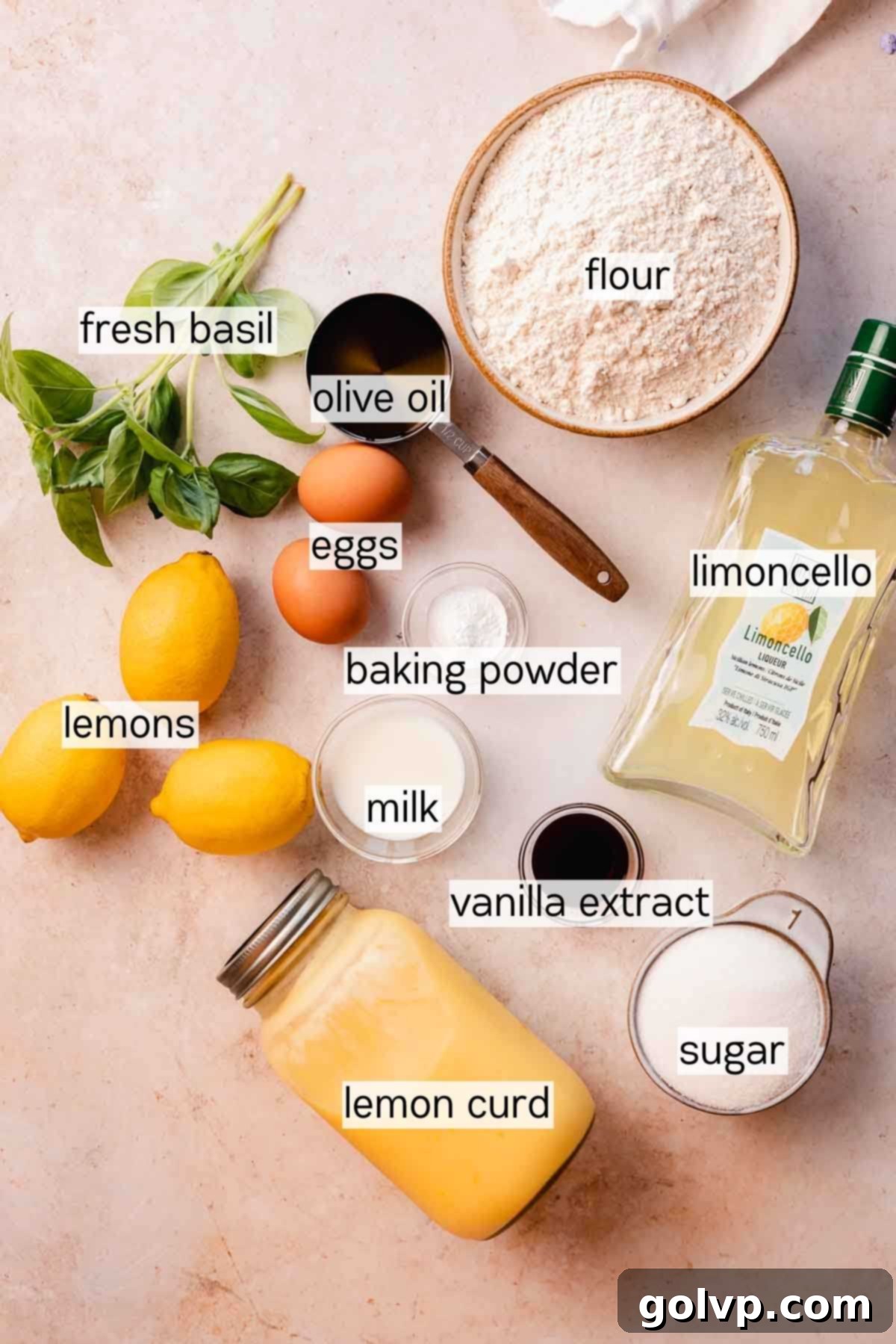
Olive Oil: The choice of olive oil significantly impacts the cookie’s flavor. I prefer using an extra virgin olive oil with a robust, fruity flavor profile, as it contributes a beautiful, subtle earthiness that perfectly complements the bright lemon. If you’re less keen on a strong olive oil presence, a lighter olive oil or even a neutral vegetable oil can be substituted. However, for that authentic Italian touch, don’t shy away from a good quality EVOO.
Lemons: Freshness is paramount here! You’ll need the vibrant zest for the cookie dough to infuse it with intense citrus aroma, and whole lemons for both the juice and zest in the delightful syrup. Always use organic, unwaxed lemons if possible, and zest them carefully to avoid the bitter white pith. The brighter the lemon, the more exquisite your cookies will taste.
Lemon Curd: This tangy, gooey filling is the heart of these cookies. You can elevate your cookies by making my go-to tangy and zesty lemon curd from scratch, ensuring a fresh and vibrant flavor. Alternatively, for a convenient shortcut without compromising too much on taste, a high-quality premade lemon curd from your local grocery store will also work beautifully. Just ensure it’s thick enough to hold its shape when the cookies are assembled.
Fresh Basil: The basil is a game-changer, adding a subtle, refreshing herby note to the syrup that surprisingly enhances the lemon. You can adjust the amount of basil in the syrup to your preference, from a delicate hint to a more pronounced herbal bouquet. Beyond flavor, fresh basil sprigs and leaves are crucial for the aesthetic, serving as the “lemon leaves” for decoration. Remember that fresh basil wilts quickly, so for the best visual appeal, add these decorative leaves just before serving.
All-Purpose Flour: Precision in measuring flour is key for the perfect cookie texture. I highly recommend weighing your flour with a kitchen scale for the most accurate and consistent results. If a scale isn’t available, employ the “spoon and level” method: gently stir the flour in its bag, then spoon it lightly into your measuring cup without packing it down. Finally, scrape off the excess with the flat edge of a knife to ensure you have just the right amount, preventing dense or dry cookies.
Limoncello: This iconic Italian lemon liqueur, made from the zest of Femminello St. Teresa lemons, adds an unparalleled layer of fragrant lemon flavor to the syrup. While it’s a subtle addition and won’t make the cookies taste strongly alcoholic, it contributes a depth and authenticity that is hard to replicate. If you prefer to omit alcohol, you can leave it out entirely, or you can add it to the simmering syrup to cook off the alcohol content while retaining much of its distinctive flavor.
👩🍳 Crafting These Delicious Italian Lemon Cookies: A Step-by-Step Guide
Lemon Olive Oil Cookie Dough: Step by Step
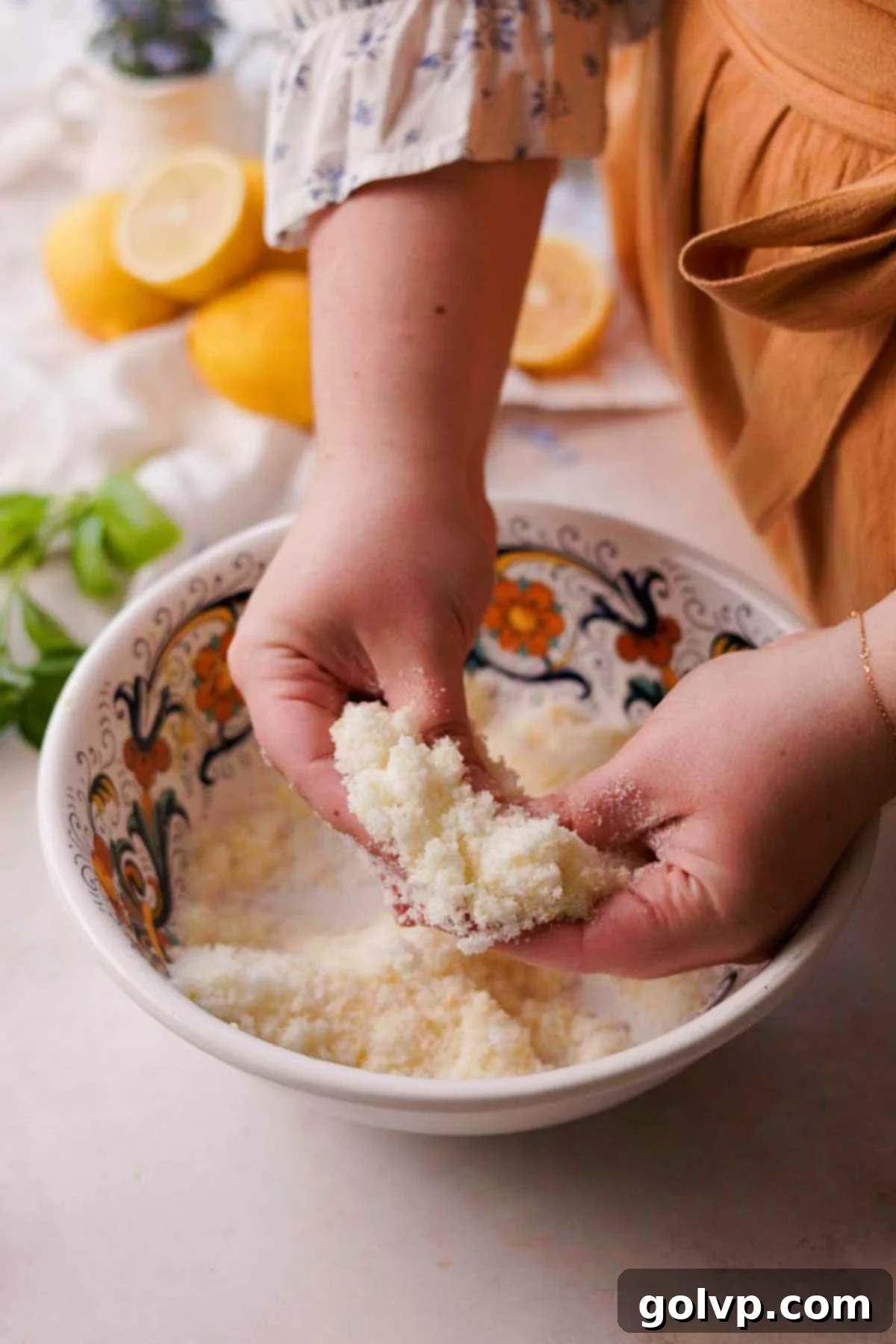
Step 1: Infuse the Sugar with Lemon Zest. In a large mixing bowl, combine the granulated sugar and lemon zest. Use your fingertips to rub the zest into the sugar. This crucial step helps release the aromatic oils from the lemon zest, infusing the sugar with a deep, vibrant lemon fragrance and flavor. Continue rubbing until the sugar feels slightly moistened and intensely fragrant.
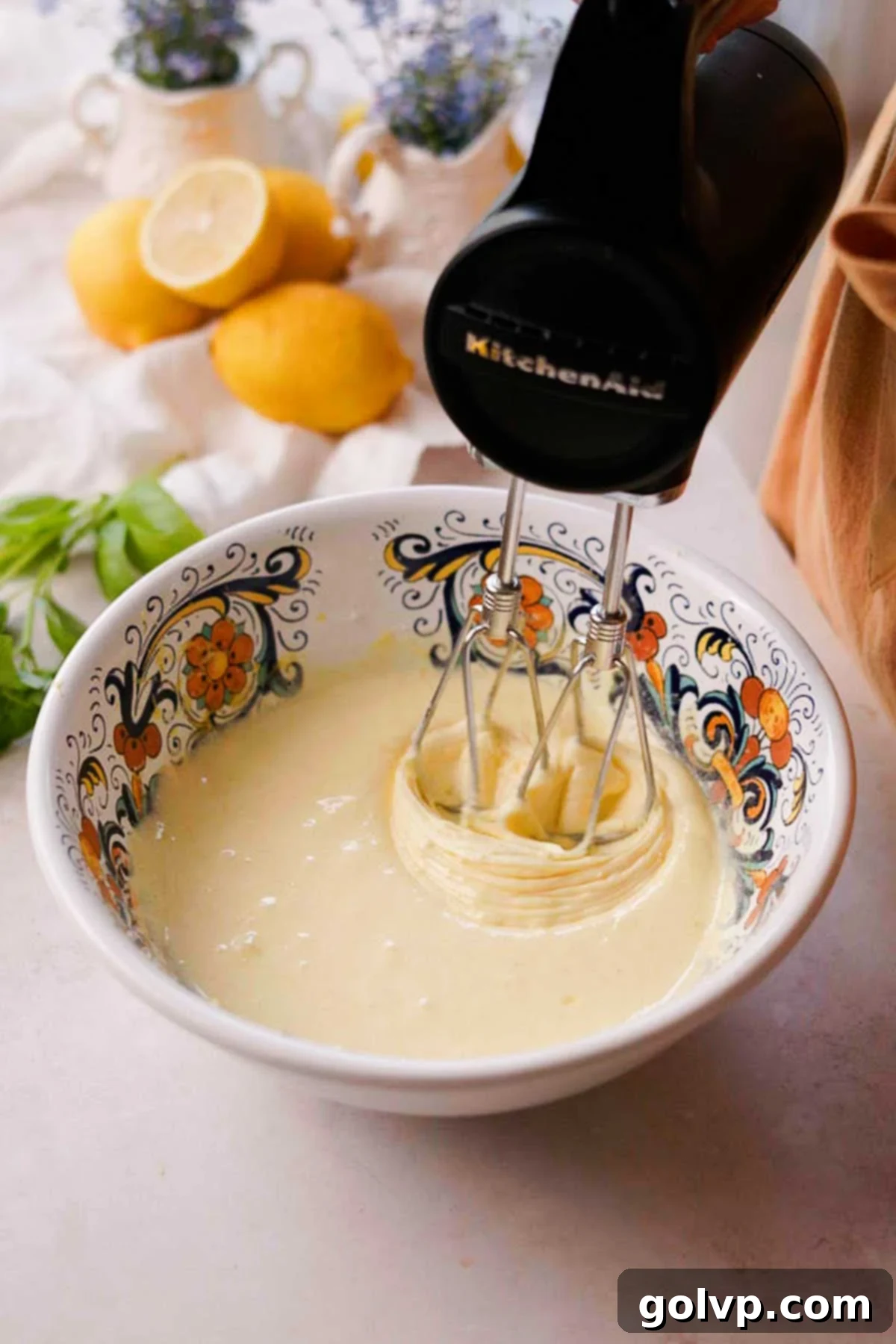
Step 2: Create a Light and Airy Base. Add the large eggs to the lemon-infused sugar mixture. Using an electric mixer, beat on medium-high speed for approximately 5 minutes until the mixture becomes thick, pale yellow, and significantly increased in volume. This aeration step is vital for creating the soft, cake-like texture of the cookies.
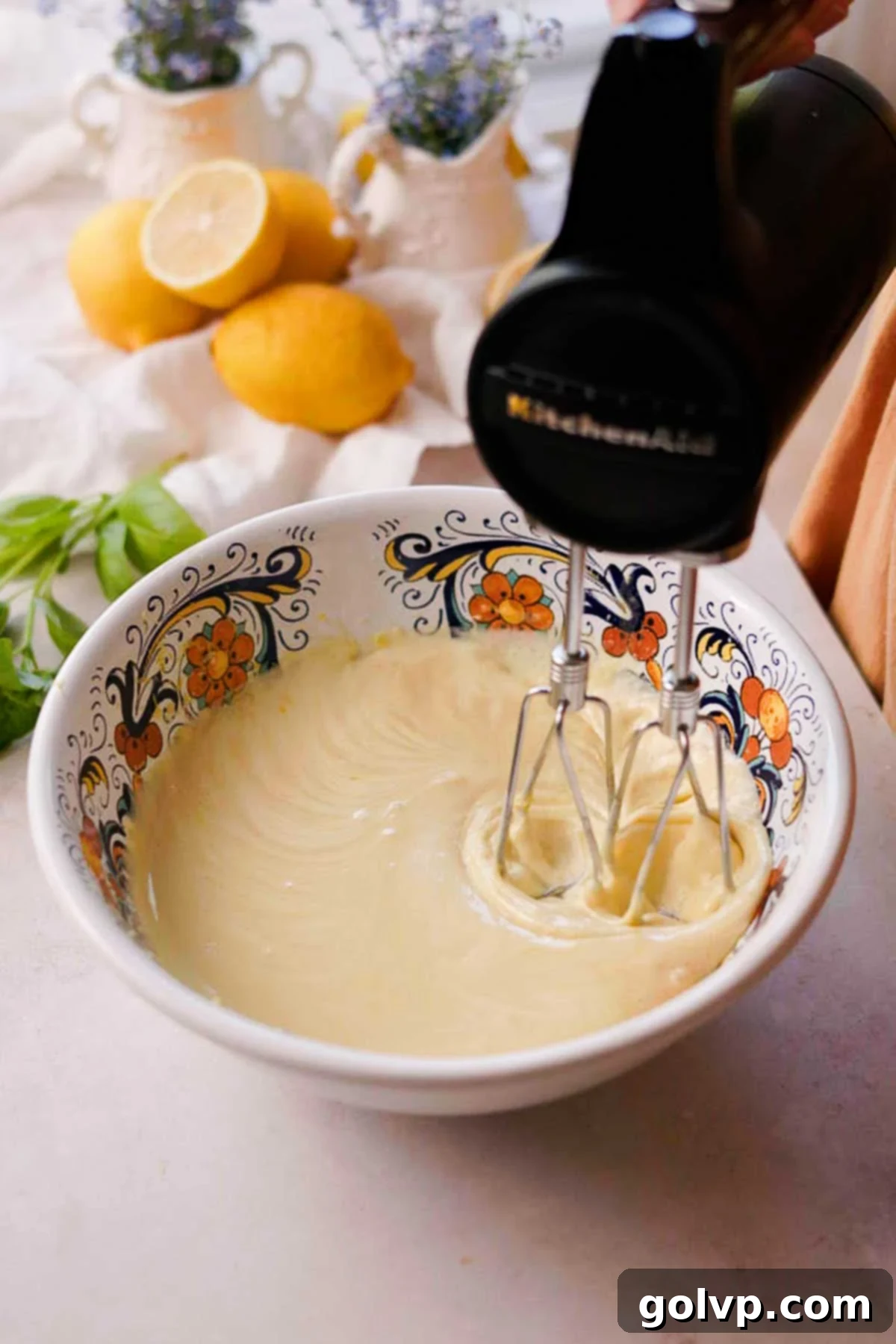
Step 3: Incorporate Wet Ingredients. Gently add the olive oil, milk, pure vanilla extract, and sea salt to the egg mixture. Mix on low speed with the electric mixer just until all ingredients are combined. Be careful not to overmix at this stage; we want to maintain the airiness developed in the previous step.
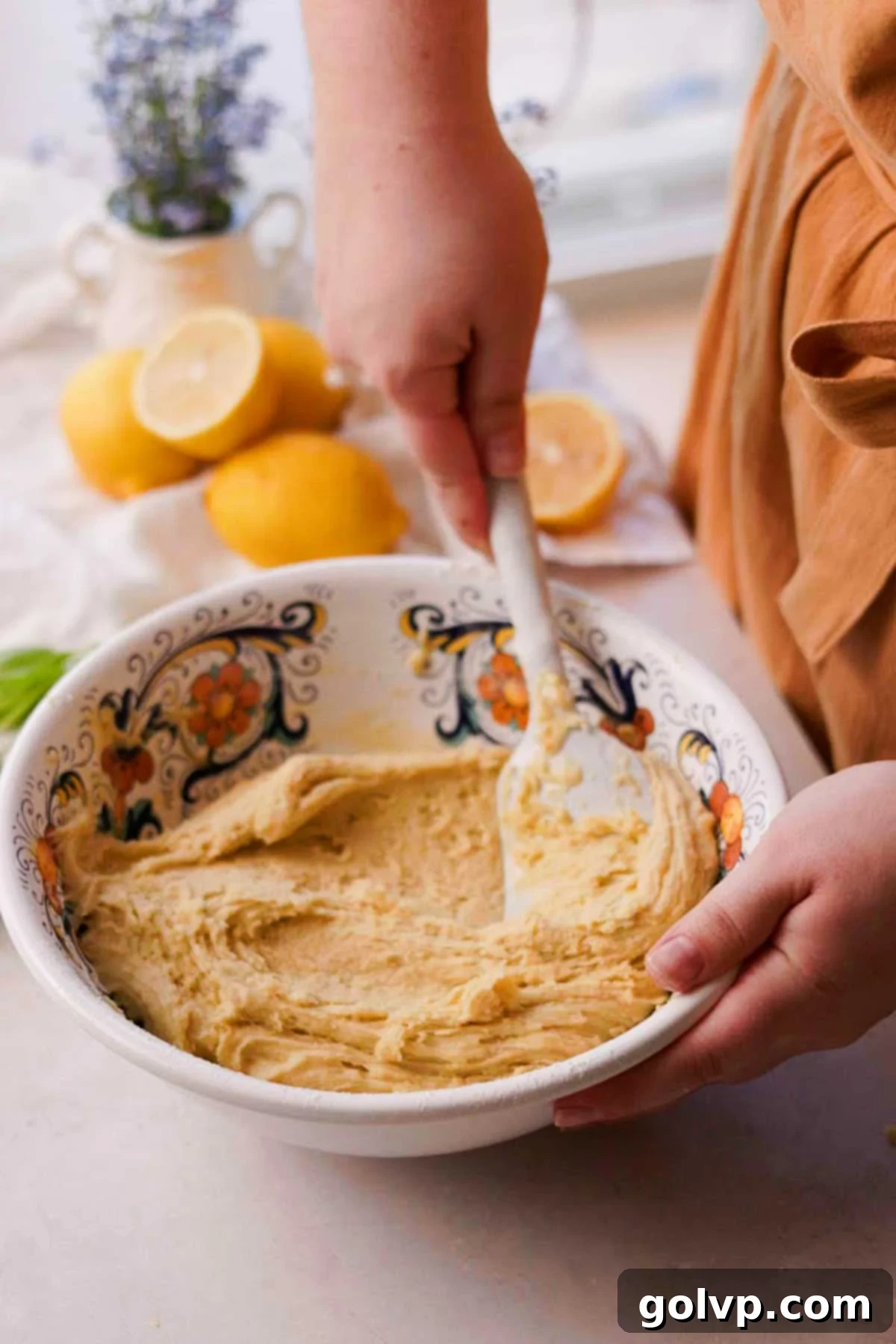
Step 4: Form the Dough and Chill. Sift the all-purpose flour and baking powder directly over the wet ingredients. Using a spatula, gently fold the dry ingredients into the wet until a soft, cohesive cookie dough forms. Avoid overmixing, which can lead to tough cookies. Once combined, cover the bowl and refrigerate the dough for 1-2 hours. This chilling period is essential: it allows the flour to fully hydrate, the flavors to meld, and the dough to firm up, making it much easier to handle and shape, and preventing the cookies from spreading too much during baking.
While the dough chills, preheat your oven to 355°F (180°C) and prepare a baking sheet by lining it with parchment paper.
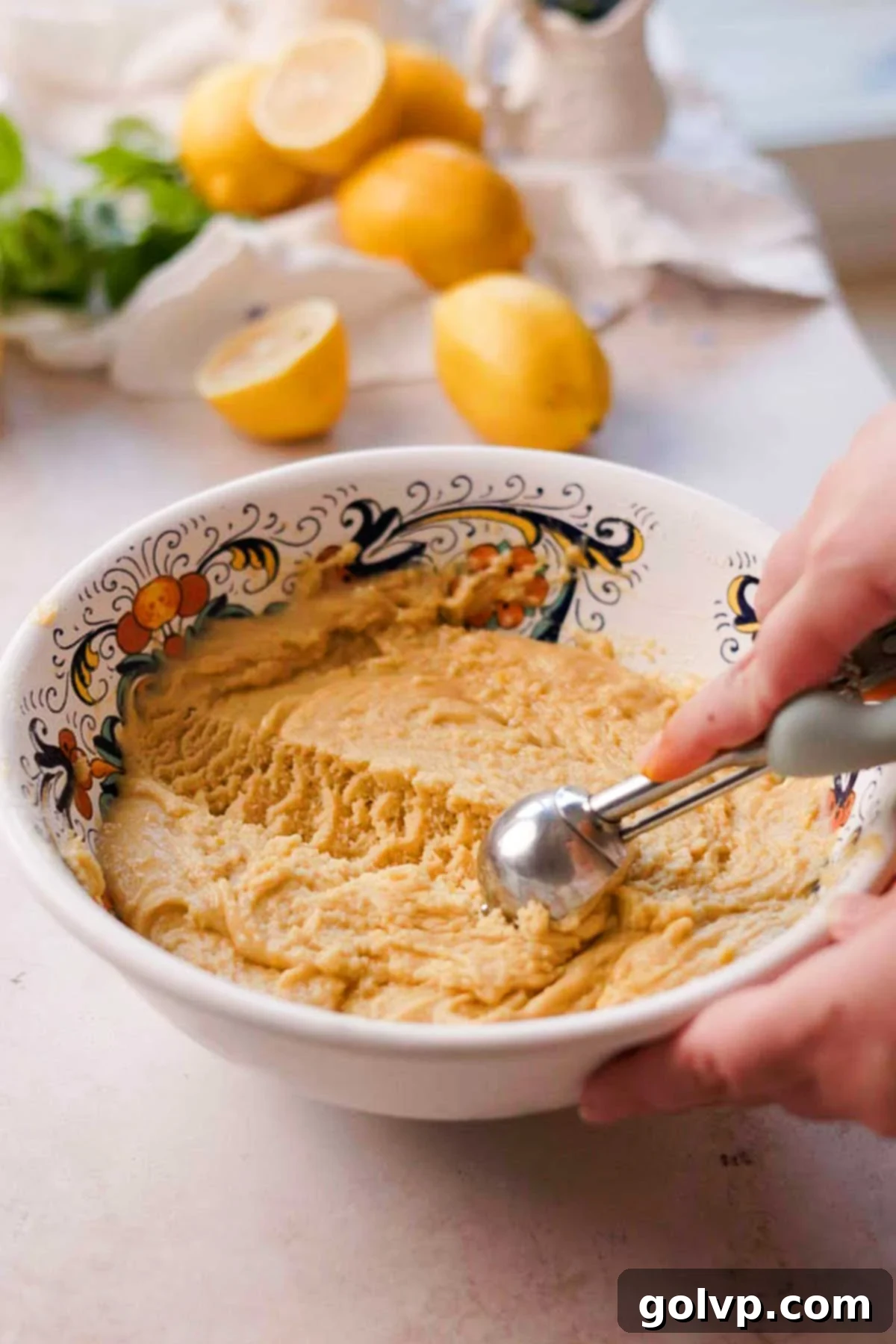
Step 5: Portion the Cookie Dough. Once chilled, use a 2-tablespoon cookie scoop to portion the dough evenly. This should yield approximately 24 cookies, ensuring uniform size and baking time for each lemon treat.
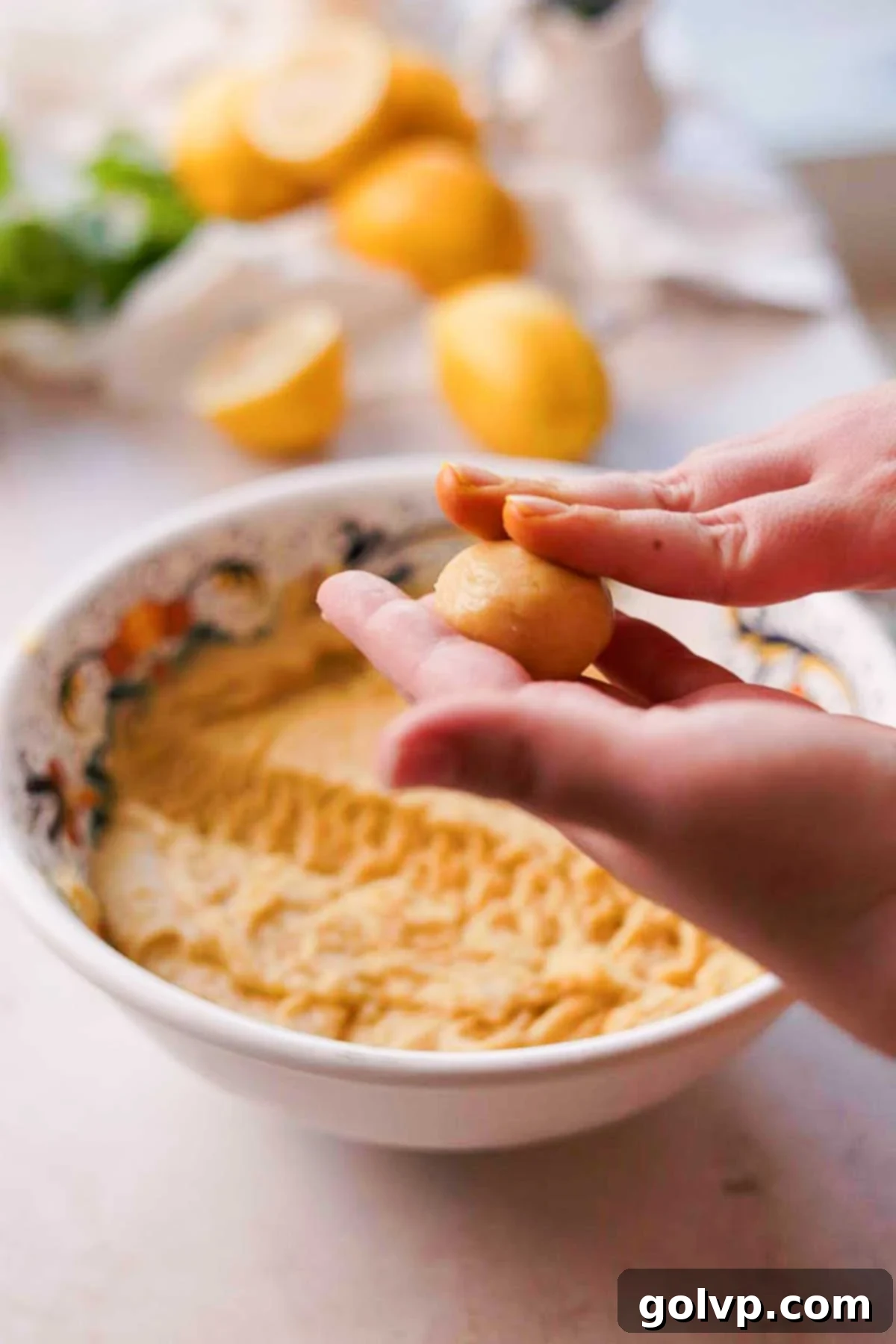
Step 6: Shape into Smooth Spheres. Take each portioned piece of dough and roll it between your palms to form a perfectly smooth, round ball. If you find the dough is a bit sticky and adheres to your hands, lightly moisten your palms with a tiny bit of water. This will help you achieve a smooth finish without adding too much extra flour to the dough.
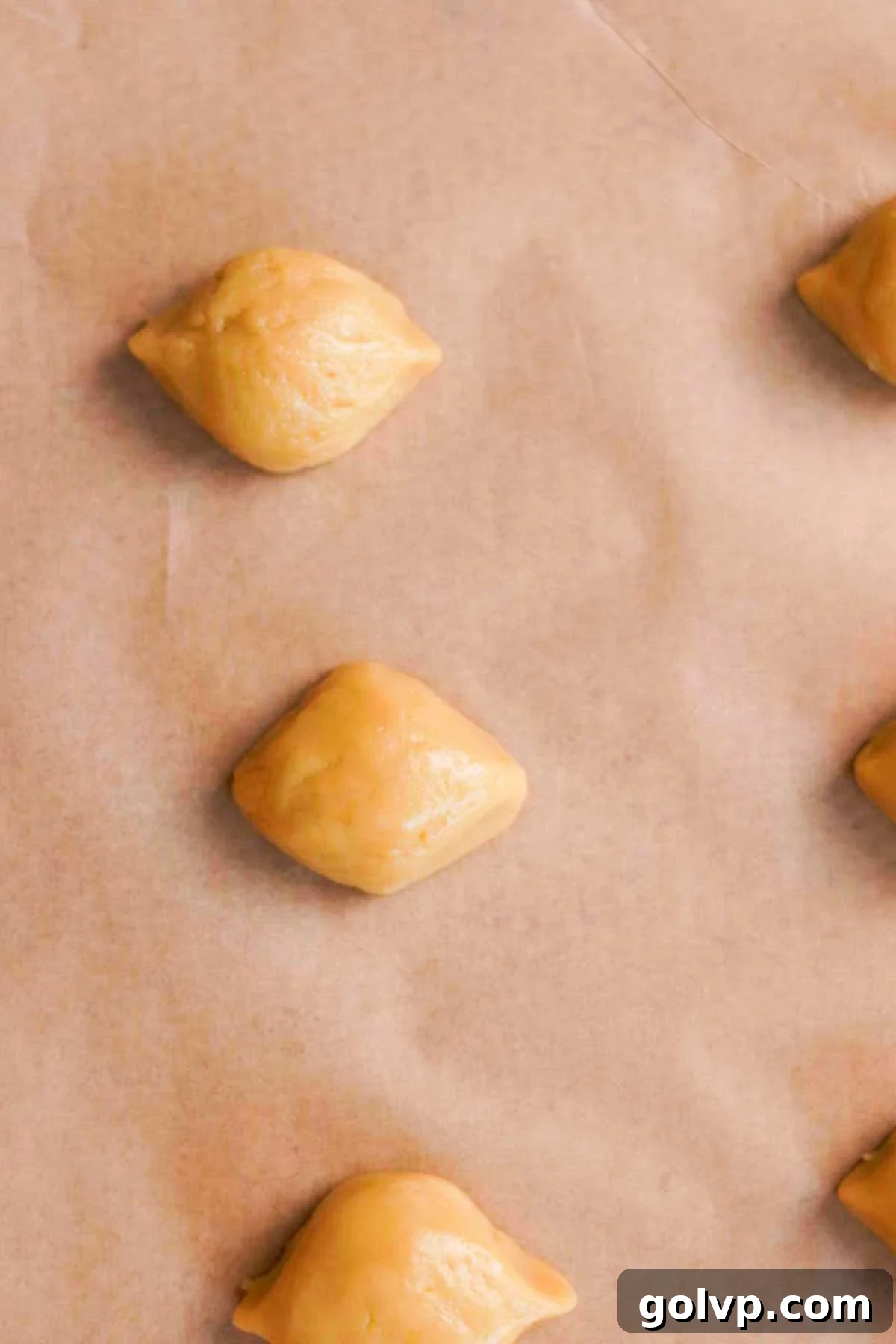
Step 7: Form the Signature Lemon Shape and Bake. Place the smooth cookie dough balls onto the parchment-lined baking sheet, ensuring there’s about 2 inches of space between each to allow for even baking. To create the distinctive lemon shape, gently use your fingers to pinch two opposite sides of each cookie. This subtle manipulation before baking will give them that charming, natural lemon contour. Bake the cookies for 11-12 minutes, or until the bottoms are lightly golden brown. It’s crucial not to overbake them, as they should remain soft and tender, but also not underbake, as they need to be firm enough for the next steps.

Step 8: Hollow Out for the Filling. As soon as the cookies are cool enough to comfortably handle, but still warm, carefully use a small, sharp knife (a paring knife works well) to cut out a small cavity from the bottom center of each cookie. This delicate operation is much easier when the cookies are slightly warm, as they are less likely to crumble. This hollowed-out space is where the tangy lemon curd will reside, preparing the cookies for their delicious filling.
Lemon Basil Syrup: Step by Step
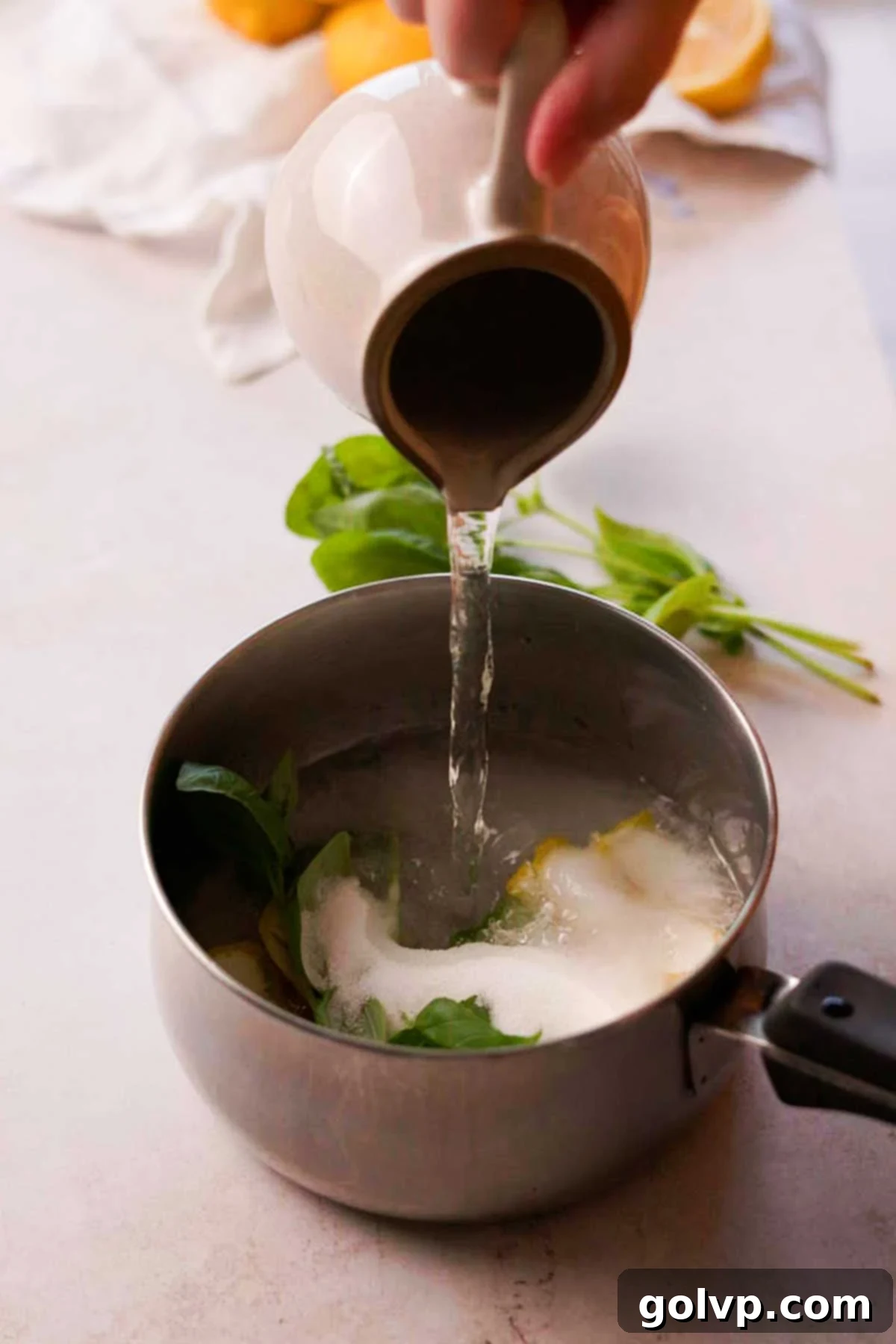
Step 1: Combine Syrup Base Ingredients. In a medium saucepan, combine the granulated sugar, water, fresh basil sprigs (if using), and pure vanilla extract. These ingredients will form the aromatic foundation of your vibrant dipping syrup.
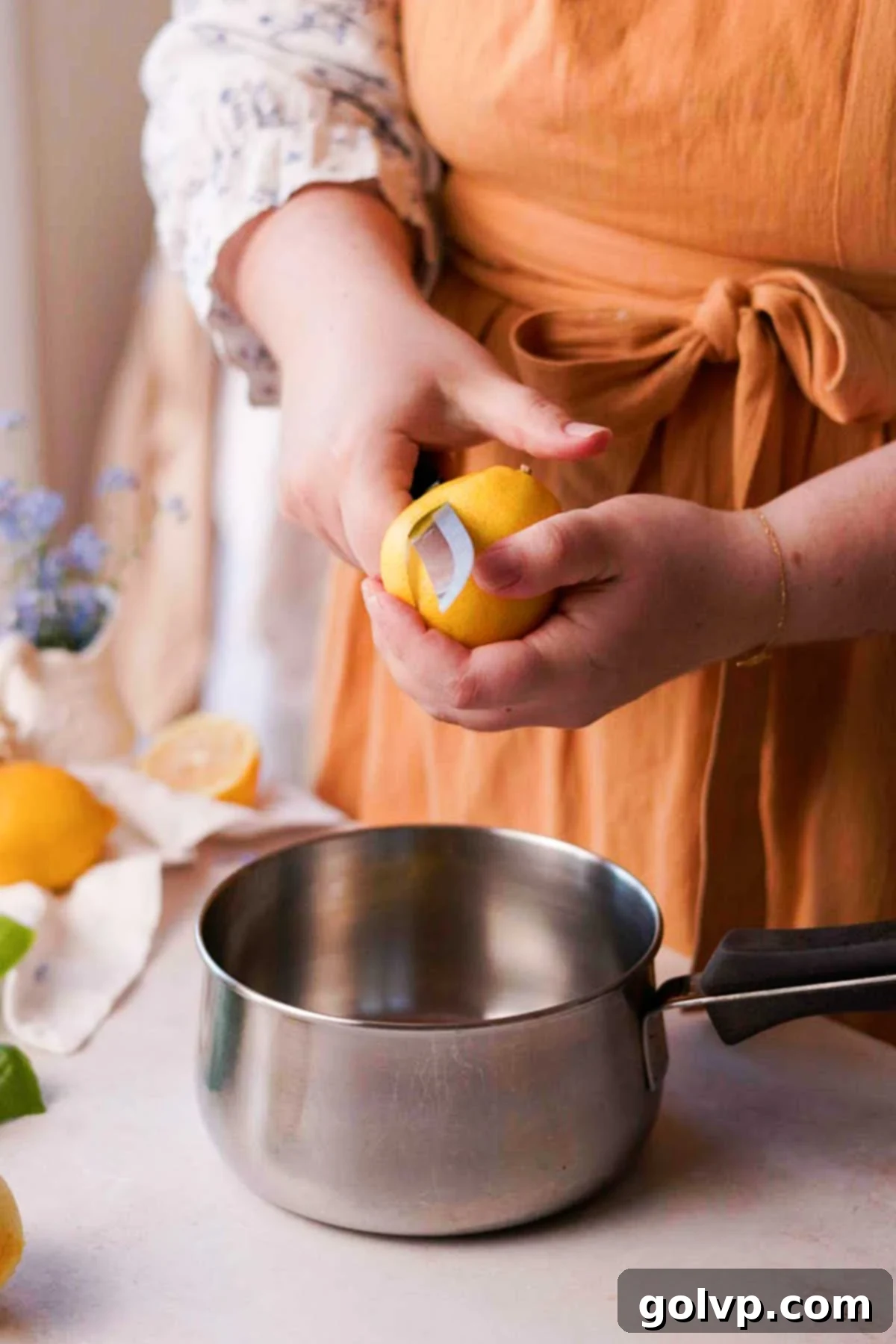
Step 2: Add Fresh Lemon Flavor. Using a sharp knife or a potato peeler, carefully peel the zest from the lemons, ensuring you only remove the bright yellow outer layer and avoid the bitter white pith beneath. Add these lemon zests to the saucepan. Then, squeeze the fresh lemon juice directly into the saucepan as well. The combination of zest and juice will provide an intense, authentic lemon flavor to the syrup.
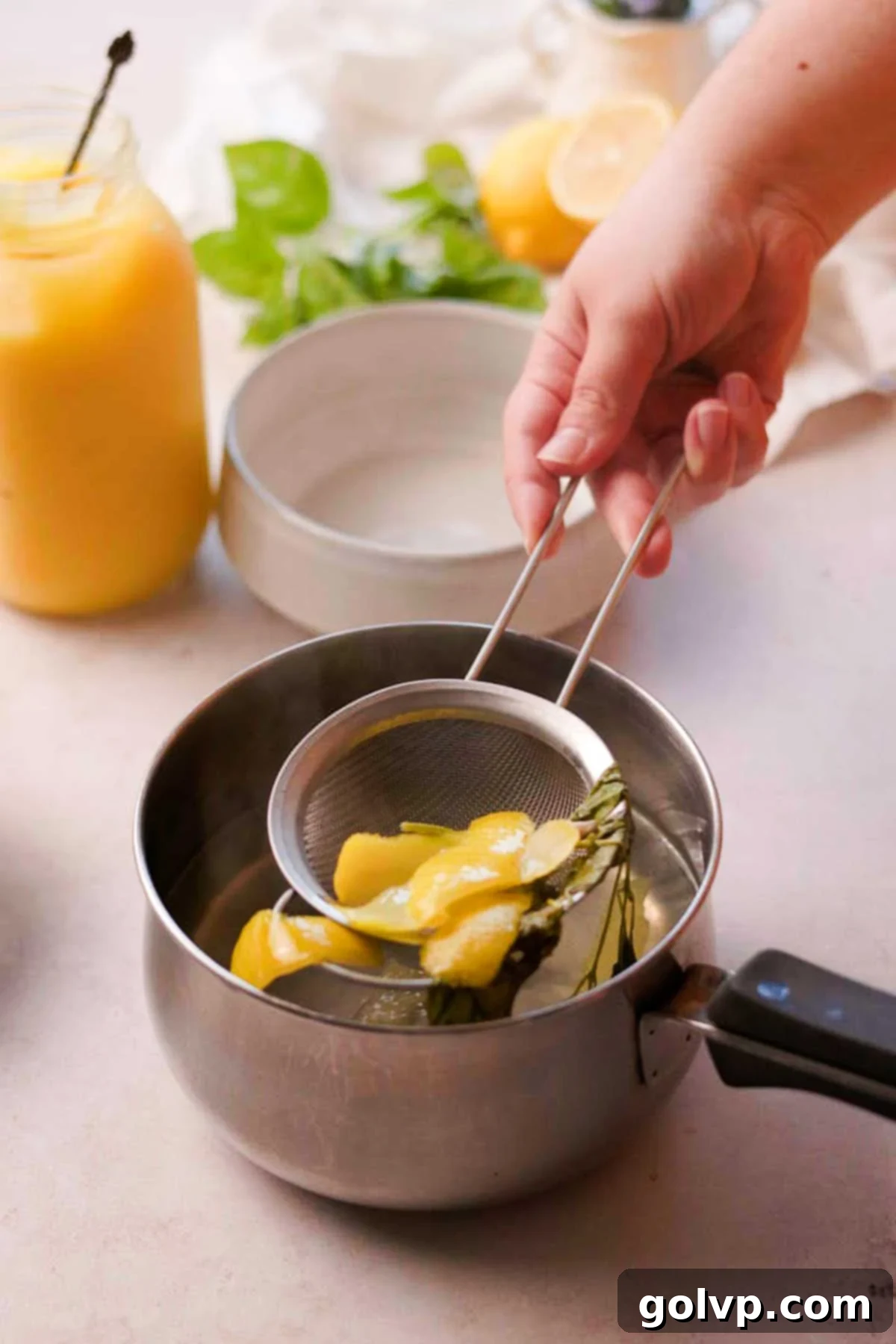
Step 3: Simmer, Cool, and Infuse with Limoncello. Heat the syrup mixture over medium heat, bringing it to a gentle simmer. Allow it to simmer for a few minutes to let the flavors meld and the basil and lemon to fully infuse the liquid. Then, remove the saucepan from the heat. Let the syrup cool slightly before stirring in the limoncello. Adding limoncello while the syrup is hot can cause some of the delicate alcohol flavor to evaporate. Once cooled, strain out the basil sprigs and lemon zest, leaving behind a beautifully clear and fragrant syrup.
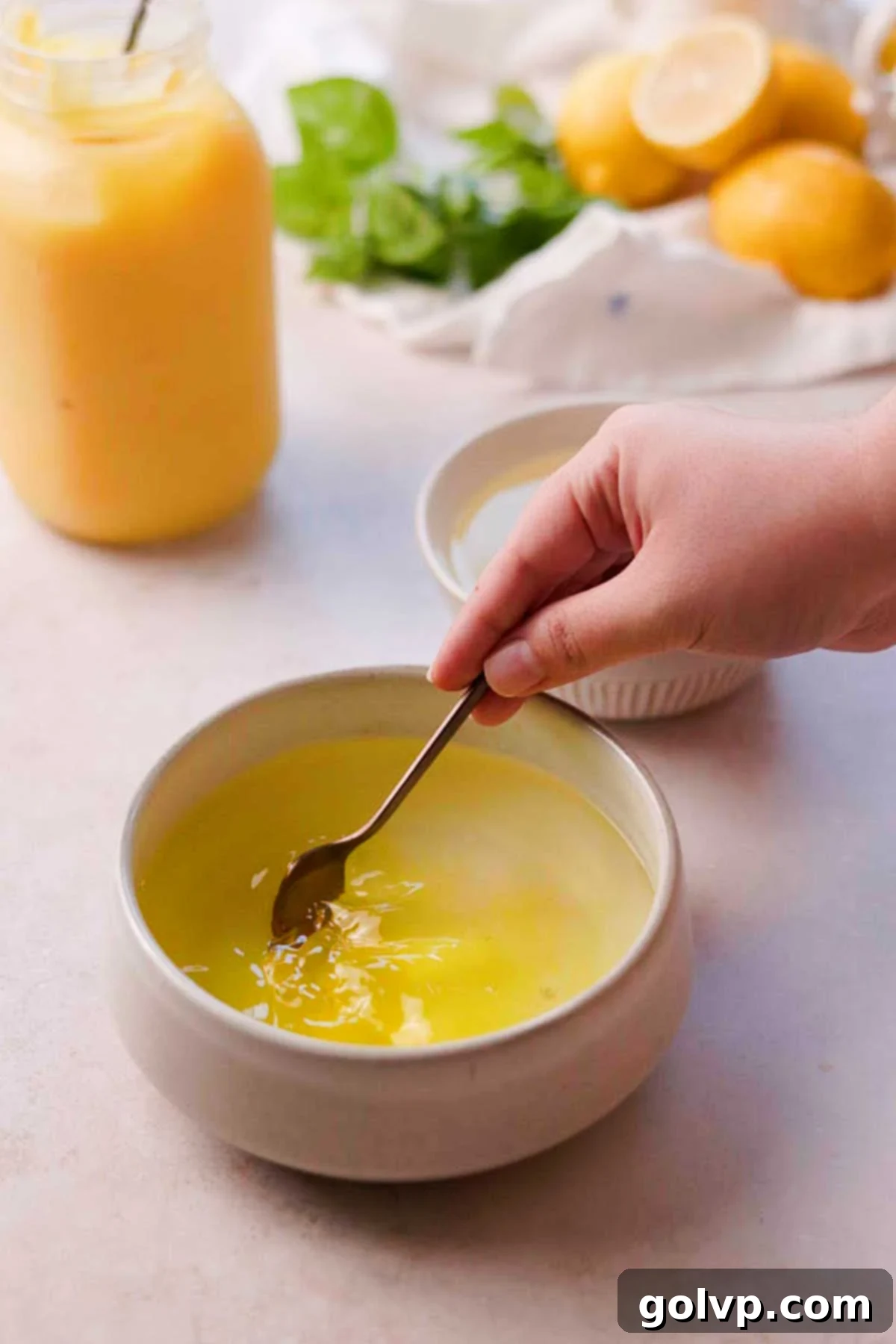
Step 4: Color the Syrup. Divide the strained syrup into two separate bowls. Into one bowl, add enough yellow food coloring to create a vibrant, bright lemon-yellow hue. In the second bowl, add green food coloring until you achieve a distinct and bright green shade. It’s important to make the colors quite intense, as they will appear lighter when absorbed by the cookies. Both liquid and gel food colorings work well for this step.
Italian Lemon Cookie Assembly: Step by Step
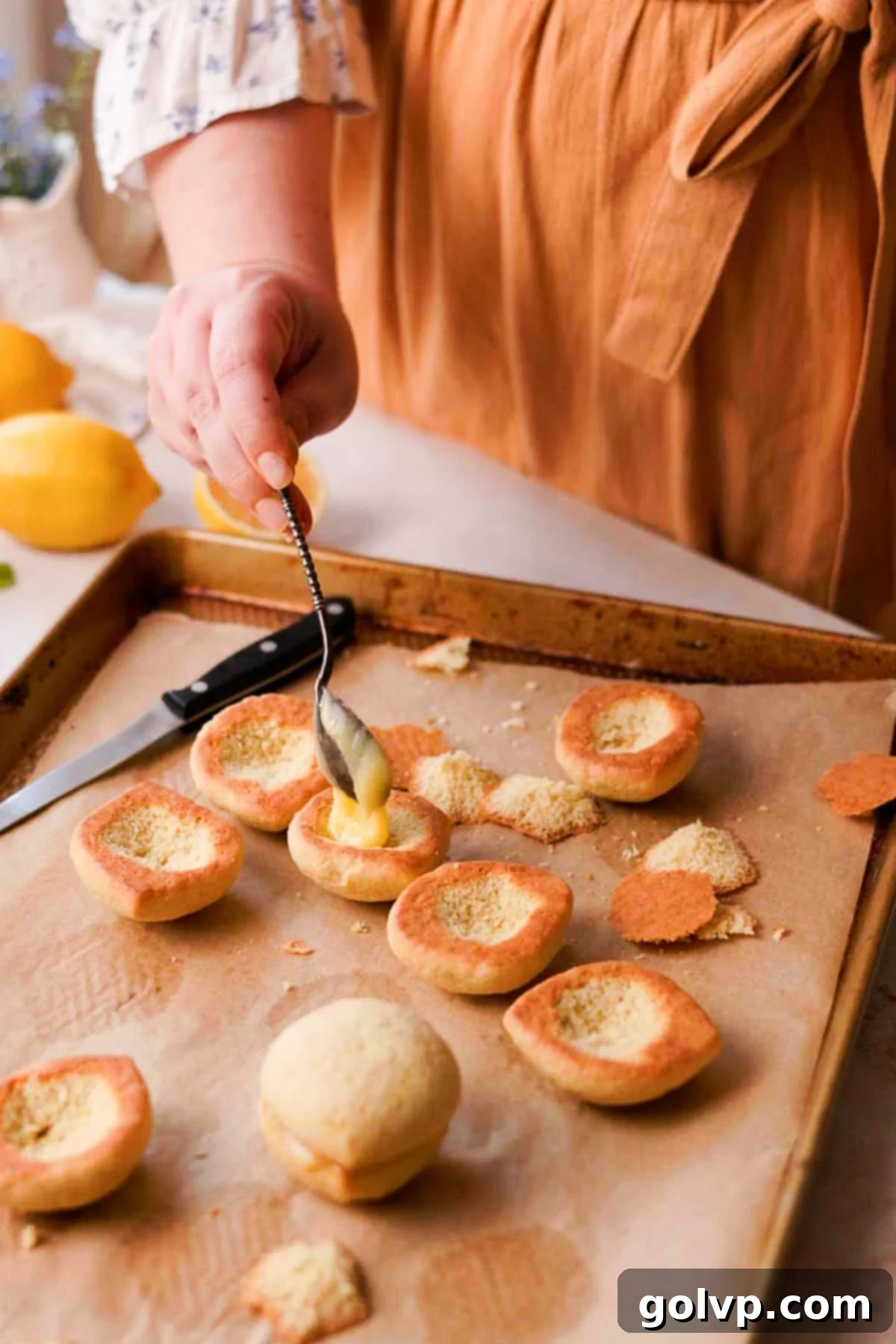
Step 1: Fill the Cookie Halves. For efficient assembly, I recommend filling all the cookies first, and then proceeding to dip them in the syrup. Carefully match up the hollowed cookie halves so that they are similar in size. Generously fill both halves with your tangy lemon curd. Be mindful not to overfill, as excess curd will ooze out when the cookies are pressed together.
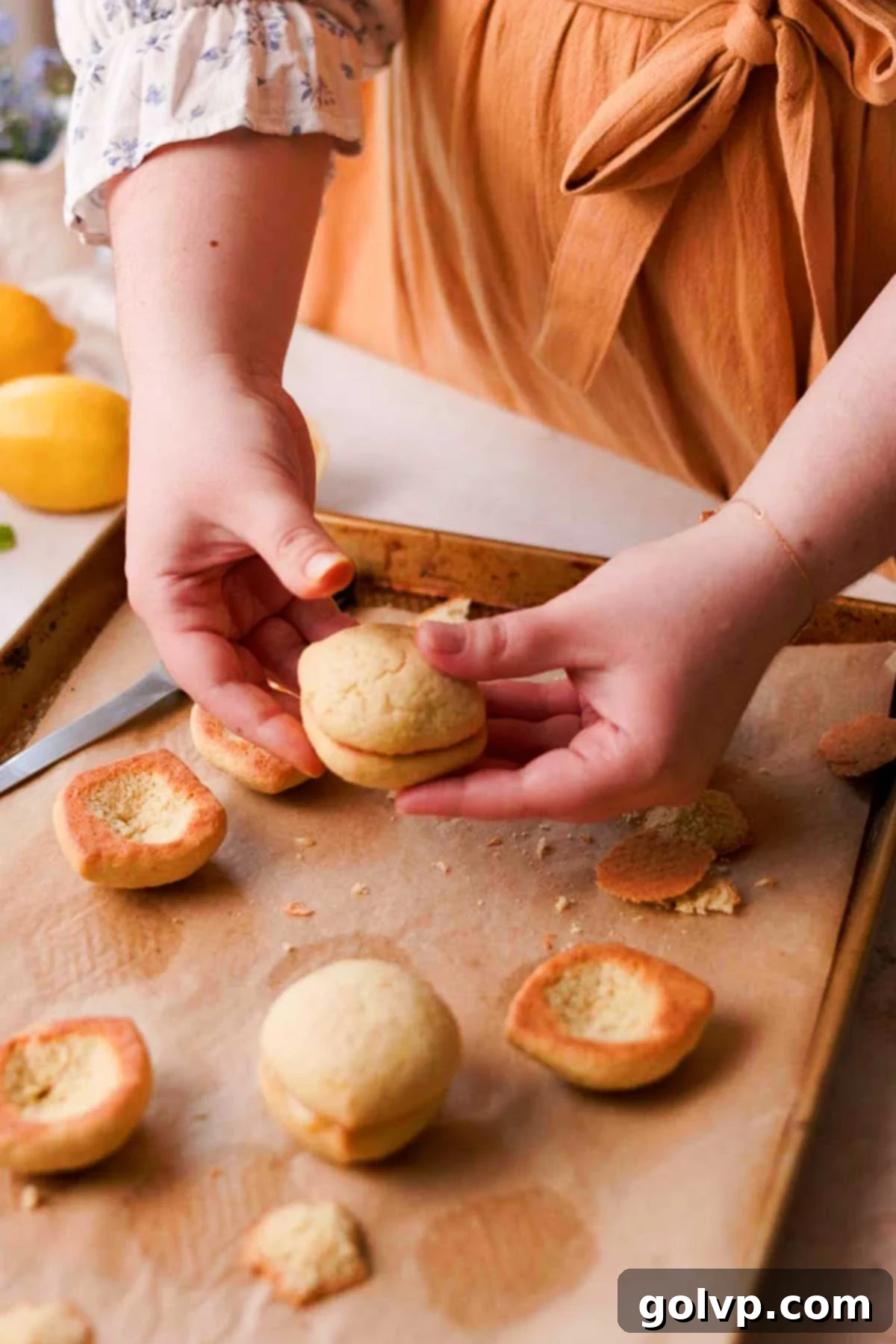
Step 2: Assemble the Lemon Cookies. Gently but firmly press the two filled cookie halves together, creating a complete lemon shape. The lemon curd acts as a delicious adhesive, holding the halves securely. If any lemon curd seeps out from the edges, simply wipe it away with a clean finger for a neat finish.
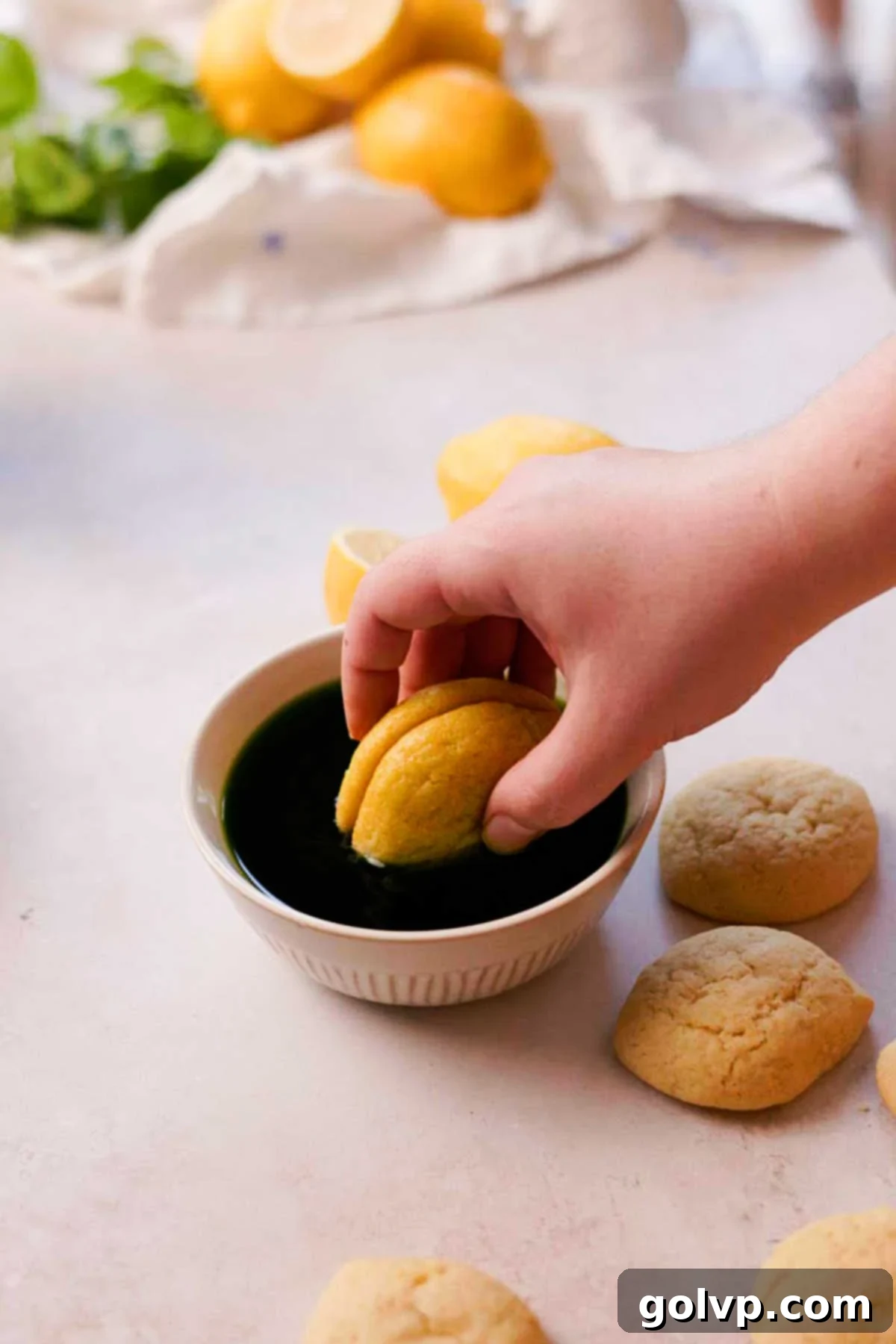
Step 4: Dip in Colored Syrups. Working with one assembled cookie at a time, briefly dunk one half of the lemon cookie into the vibrant yellow syrup. Immediately turn the cookie and briefly dunk the other half into the green syrup. The key is a quick, brief dip to ensure the cookies absorb just enough moisture without becoming soggy. Gently shake off any excess syrup and place the dipped cookies onto a clean tray or wire rack to allow the syrup to soak in beautifully.
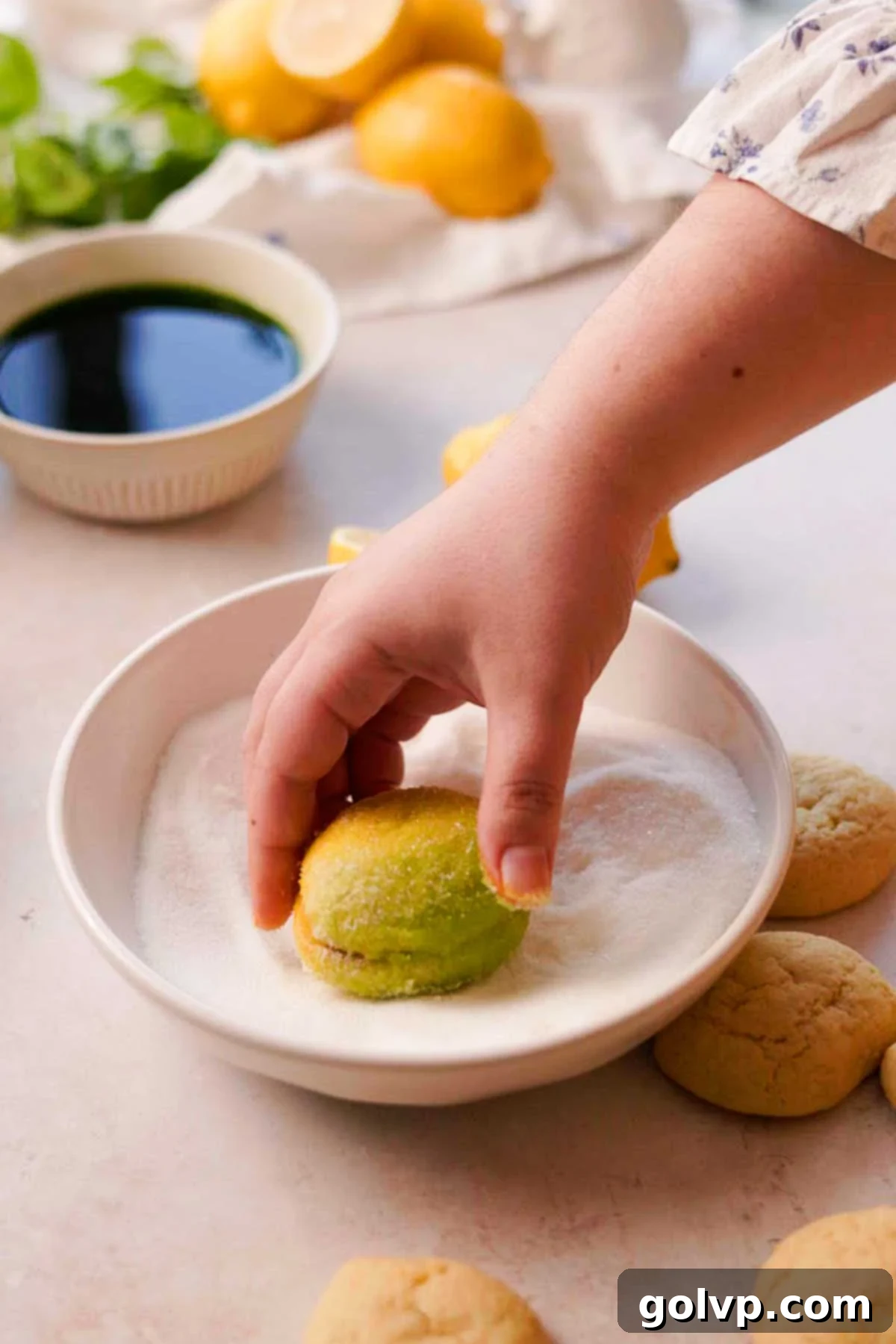
Step 5: Sugar Coat and Garnish. Once all the lemon olive oil cookies have been dipped in the two-toned syrup, it’s time for the final touches. For a lighter, less sweet coating, simply sprinkle both sides of the cookies with granulated sugar. For a more pronounced sweetness and sparkling finish, roll the entire cookie in a bowl of granulated sugar. Finally, to truly mimic a fresh lemon, gently insert a small fresh basil leaf (or a small sprig with a leaf) into one side of each cookie. This adds a beautiful visual element and a final subtle aromatic hint. Remember to add these basil “leaves” just before serving for optimal freshness and appearance.
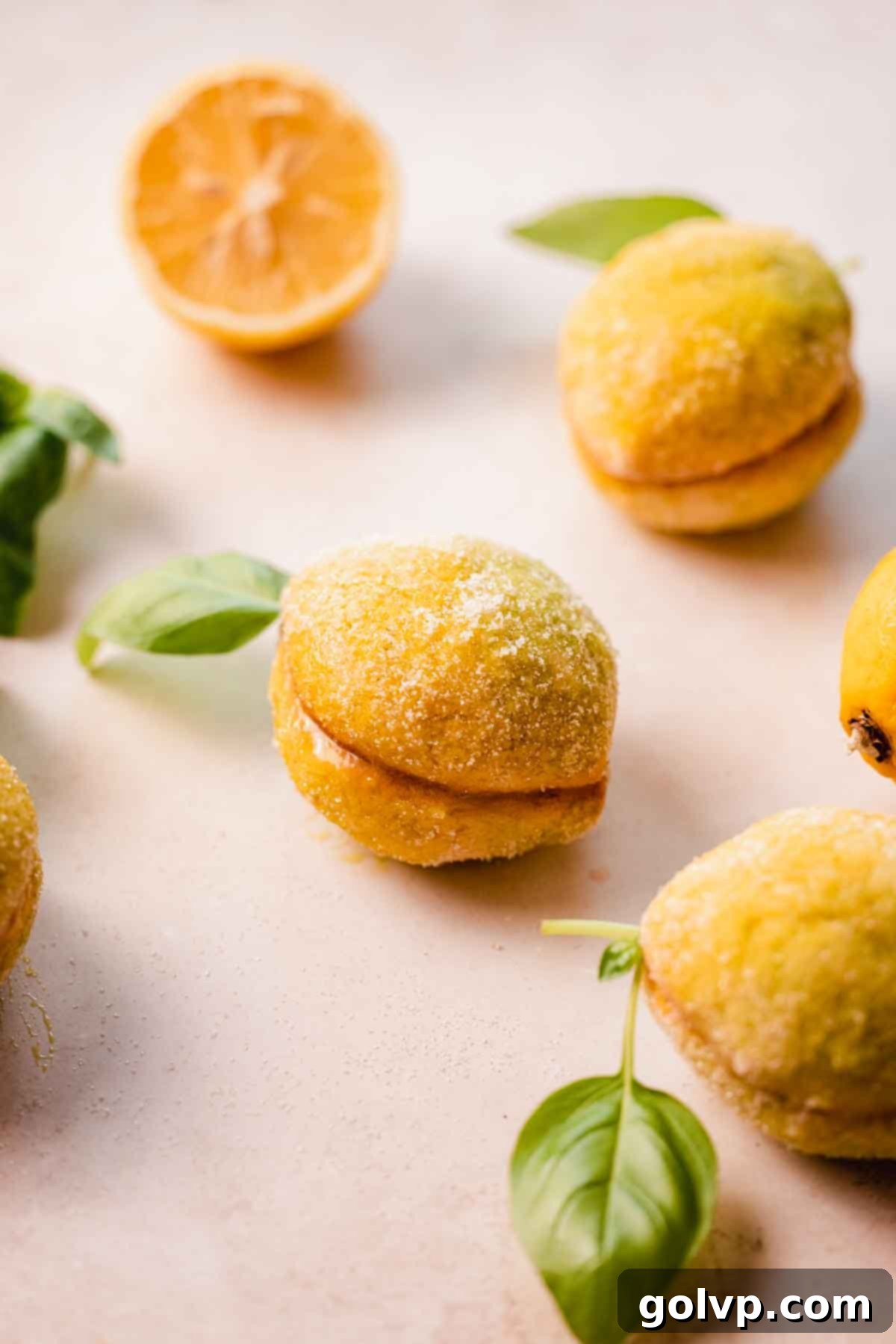
✔️ Expert Tips for Perfect Italian Lemon Olive Oil Cookies
- Don’t Skip Chilling the Cookie Dough: This step is non-negotiable for success. Chilling the dough for at least an hour does several things: it allows the flour to fully hydrate, resulting in a more tender cookie; it solidifies the fats, which helps prevent the cookies from spreading too much during baking; and it makes the dough much easier to handle and shape, ensuring those distinct lemon forms hold up beautifully. A well-chilled dough is key to a beautiful, soft, and perfectly shaped cookie.
- Bake the Cookies Just Right: Precision in baking time is crucial for these delicate cookies. Set a timer and keep a close eye on them; they are ready when the bottoms are lightly golden brown, but the tops remain pale. The cookies need to be firm enough to maintain their shape when handled and dipped in syrup, yet soft enough to allow you to easily carve out the centers for the lemon curd filling. Overbaking will result in dry, crumbly cookies, while underbaking can make them too fragile for assembly.
- Briefly Dunk, Don’t Over-Soak in Syrup: The syrup dipping step is about infusing flavor and moisture, not saturating the cookies. A quick “in and out” motion for each side is all that’s required. If you leave the cookies in the syrup for too long, they will absorb too much liquid and become soggy, losing their delightful cake-like texture and potentially falling apart. The goal is a light, flavorful coating that adds to the cookie’s tenderness.
- Ensure Fresh, Room Temperature Ingredients: Using room temperature eggs and milk for the cookie dough is important for creating a smooth, emulsified batter. Cold ingredients can cause the batter to curdle and affect the final texture. For lemons, always opt for fresh, unwaxed ones for the best zest and juice.
- Proper Flour Measurement: As mentioned, weighing your flour is always best. Incorrect flour measurements can drastically change the cookie’s consistency, making it either too dry and crumbly or too wet and sticky. Consistency is key here.
🥄 Make-Ahead & Storage Solutions for Your Italian Lemon Cookies
These Italian lemon olive oil cookies are fantastic for making ahead, which can be a huge time-saver, especially when preparing for events. Here’s a detailed breakdown of how you can prepare each component in advance and store the finished cookies:
- Lemon Olive Oil Cookie Dough: The dough is a perfect candidate for make-ahead prep. You can prepare the cookie dough the day before you plan to bake. Simply cover the bowl tightly with plastic wrap to prevent the top from drying out and store it in the refrigerator for up to 24 hours. The chill time will also work in your favor, enhancing the flavors and making the dough easier to handle.
- Baked Lemon Olive Oil Cookies (Unfilled): If you want to get a head start on baking, you can bake the cookies ahead of time and fill and dip them later. Once baked and completely cooled, store the cookies in an airtight container in the refrigerator for up to 2 days. To prevent them from sticking together (which they tend to do when stored in layers), it’s best to place a piece of parchment paper between each layer of cookies.
- Lemon Basil Syrup: The aromatic syrup can also be prepared several days in advance. Once made and strained, transfer the syrup to an airtight jar or container and store it in the refrigerator. When you’re ready for assembly, simply take it out, divide it into two bowls, add your food coloring, and proceed with dipping the cookies.
Storage of Fully Assembled Italian Lemon Cookies:
The fully assembled, filled, and dipped Italian lemon cookies store remarkably well, maintaining their soft, moist texture. To ensure they don’t stick together and to preserve their beautiful presentation, arrange them in a single layer in an airtight container. If you need to stack them, place a sheet of parchment paper between layers. Alternatively, if storing on a tray, cover it tightly with plastic wrap to prevent them from drying out. These cookies will remain soft, moist, and delicious when refrigerated for up to 2 days.
Serving for Events:
If you are preparing these exquisite cookies for a wedding, party, or any event, it’s ideal to fill and dip them the day before. This allows the flavors to deepen and the syrup to fully permeate the cookies, enhancing their tenderness. Store them in the refrigerator as described above until just before you’re ready to serve. They are quite robust and hold up exceptionally well at room temperature for an extended period, making them an excellent choice for dessert tables where food might sit out for more than a few hours. Just remember to add the fresh basil leaves for decoration right before serving for the freshest look.
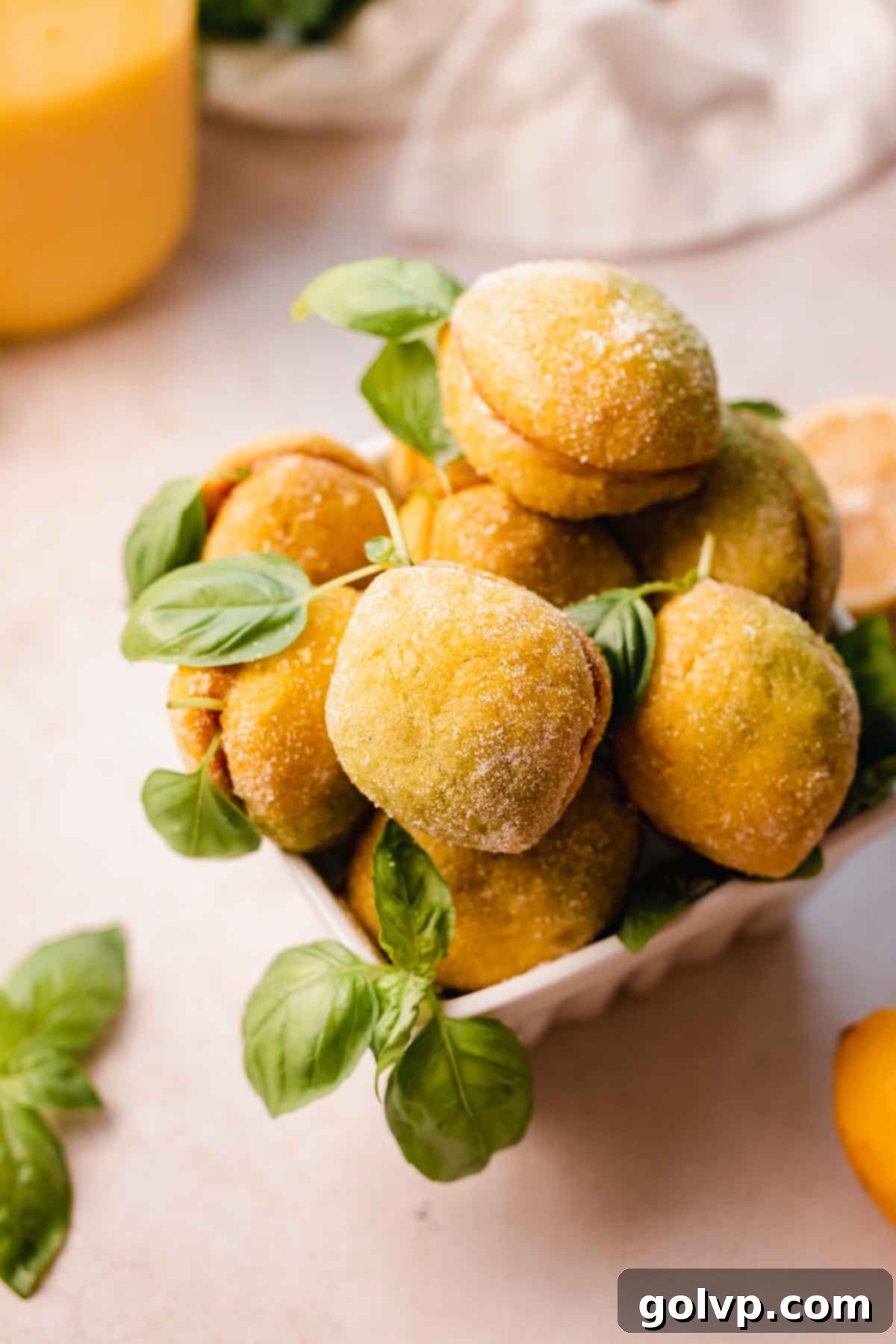
❔ What Other Delicious Fillings Can I Use for Italian Lemon Cookies?
These charming cookies draw their inspiration from traditional Italian peach wedding cookies, which are typically filled with a rich, thick custard or vibrant peach preserves. When developing this recipe, I considered both lemon curd and lemon custard. Ultimately, I settled on a zesty lemon curd because its intense tanginess and gooey texture truly amplify the overall lemon flavor profile of the cookie, creating a delightful burst of citrus with every bite. However, don’t limit yourself! A good quality lemon marmalade would also be a fantastic choice, offering a slightly more bitter, sophisticated edge.
If you’re looking to explore other flavor combinations or simply want to try something different, these Italian lemon cookies are incredibly versatile. Here are some other delightful filling options that would pair wonderfully:
- Raspberry Curd: A sweet and tart raspberry curd would provide a beautiful color contrast and a refreshing berry flavor that complements lemon exceptionally well.
- Blueberry Curd: For a burst of sweet-tart blueberry goodness, a creamy blueberry curd would be an exquisite and vibrant alternative.
- Strawberry Curd: The classic pairing of strawberry and lemon offers a familiar yet indulgent flavor, with the strawberry curd adding a luscious sweetness.
- Thick Salted Caramel or Dulce de Leche: For those who love a rich, sweet, and slightly salty contrast, a thick salted caramel or a creamy dulce de leche would provide an unexpected but utterly delicious filling. The sticky texture would also help hold the cookie halves together perfectly.
- Lemon or Orange Marmalade: Beyond lemon marmalade, a bright orange marmalade would introduce a delightful citrusy bitterness and complex sweetness, adding another layer of sophisticated flavor.
- Your Favorite Jam: Almost any thick, good quality fruit jam (apricot, cherry, or fig would be excellent) can be used. Choose a jam that isn’t too runny, so it stays neatly within the cookie cavity.
- A Thick, Creamy Custard: Returning to the traditional roots, a classic vanilla or even a delicate almond custard would offer a smooth, comforting texture and a subtly sweet flavor, allowing the lemon notes of the cookie and syrup to shine.
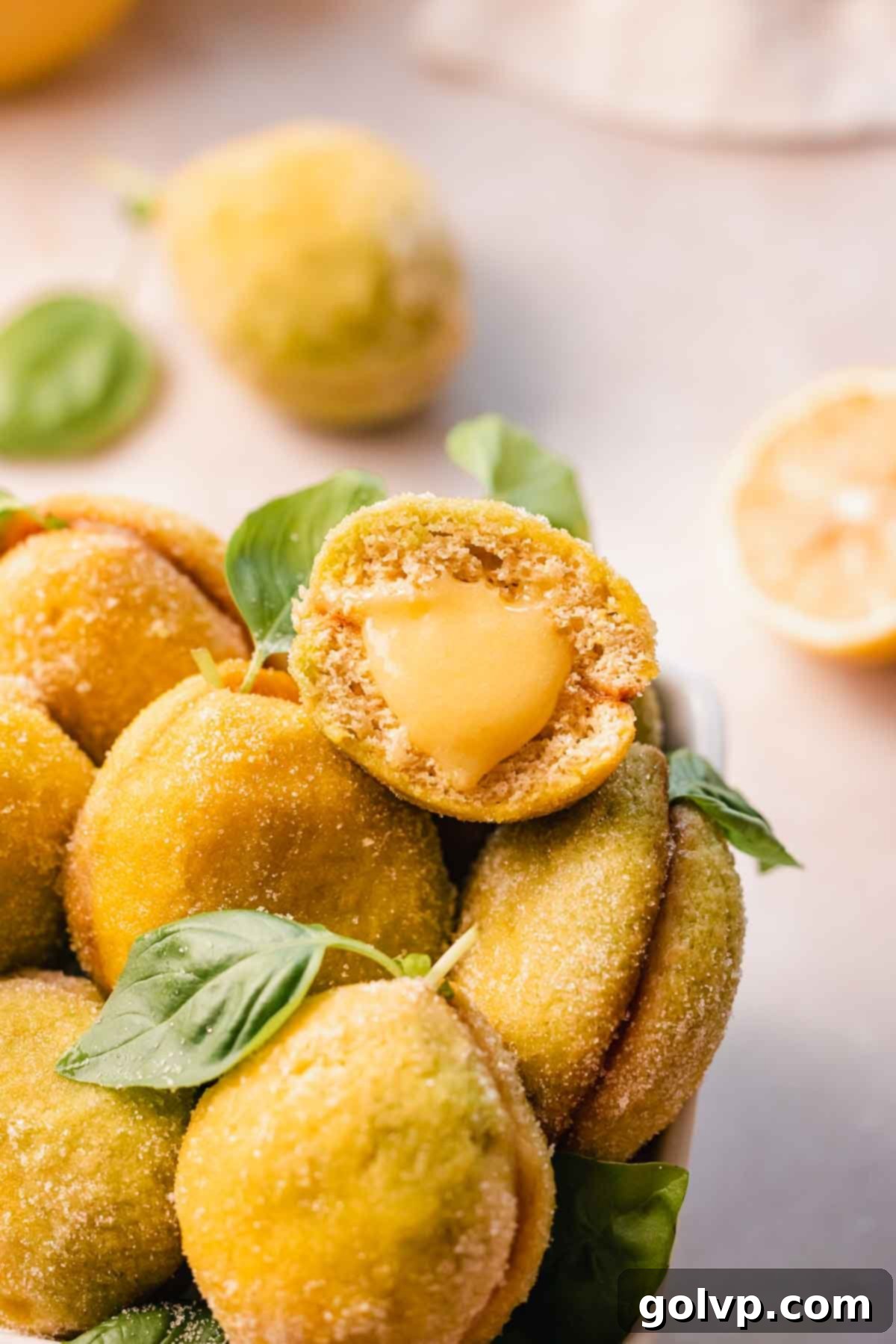
📖 Recipe FAQs
It’s very common to have leftover syrup, as having a generous amount makes it much easier to dip the cookies properly. Don’t let it go to waste! You can carefully strain out any small cookie bits or basil remnants and store the remaining syrup in an airtight container in the refrigerator for a few days. It’s wonderfully versatile: add it to summer drinks like iced tea or lemonade for a burst of fresh lemon-basil flavor, drizzle it over fresh fruit salads, or even use it to moisten other cakes or pastries. However, because the cookies were dipped directly into it, it’s best to use it within 3-4 days to ensure freshness, as it won’t have the same shelf life as an untouched simple syrup.
While I haven’t personally tested a gluten-free version of this specific recipe, many bakers have had success replacing all-purpose flour with a 1:1 gluten-free all-purpose flour blend (which typically contains xanthan gum) in similar cookie recipes. The key is to choose a high-quality blend designed for baking. If you decide to try it, please let us know how it turns out in the comments below! Your feedback helps others in the baking community.
Absolutely! These cookies are incredibly adaptable. As detailed in the “What Can I Fill Italian Lemon Cookies With?” section above, you have a wide array of choices. Any thick, creamy filling will work wonderfully to bind the cookie halves together and provide a delicious center. Consider a rich custard, your favorite fruit jam (ensure it’s not too runny), dulce de leche for a caramel note, or even a thick chocolate ganache for a luxurious twist. The most important factor is the consistency of the filling: it needs to be substantial enough to hold the cookies together and not simply run out.
Yes, you can certainly omit the limoncello if you prefer not to include alcohol in your Italian lemon cookies. While the limoncello adds a unique depth and authentic Italian flavor that truly enhances the overall lemon profile, the cookies will still be absolutely delicious without it. If you’re looking to boost the lemon flavor further in its absence, you can add a little extra lemon zest or a few drops of pure lemon extract to the syrup. Alternatively, as noted in the syrup instructions, you can add the limoncello during the simmering phase to cook off most of the alcohol while retaining some of its distinctive taste.
Yes, omitting the basil from the syrup is completely fine if it’s not to your taste. While the fresh basil adds a wonderfully subtle, refreshing, and slightly herbaceous counterpoint that beautifully complements the tangy zest of the lemon, it is an optional ingredient. The cookies will still be incredibly flavorful and delightful with just the lemon and limoncello syrup. Feel free to customize the recipe to suit your preferences!
🍋 More Zesty Lemon Recipes to Enjoy
- Lemon White Chocolate Cookies
- Lemon Shortbread Cookies
- Lemon Posset
- Lemon Curd Cookies
Did you fall in love with this recipe? I would absolutely adore hearing your thoughts and seeing your creations! Please take a moment to rate this recipe and share your experience in the comments section below. Don’t forget to share your beautiful Italian lemon cookies on Instagram and tag me @flouringkitchen so I can admire your work! For more delicious recipes and baking inspiration, be sure to follow me on Pinterest.
📖 Recipe

Italian Lemon Cookies
Mary
Pin Recipe
Shop Ingredients
Equipment
-
electric mixer
-
saucepan
Ingredients
Lemon Olive Oil Cookie Dough
- 1 cup granulated sugar
- 2 lemons zested
- 2 large eggs room temperature
- ½ cup olive oil extra virgin for more flavor or light for less flavor
- 3 tablespoons milk whole milk or milk of your choice
- 3 cups all purpose flour 360g
- 2 teaspoons baking powder
- ¼ teaspoon sea salt
- 1 tablespoon vanilla extract
Lemon Basil Syrup
- 1 cup granulated sugar
- 2 cups water
- 5 sprigs fresh basil optional
- 1 tablespoon pure vanilla extract
- 2 lemons
- ¼ cup limoncello optional
- yellow food coloring as needed
- green food coloring as needed
Filling and Assembly
- 1 cup lemon curd
- ½ cup granulated sugar for coating the cookies
- 12 fresh basil leaves for the lemon “leaves”
Shop Ingredients on Jupiter
Instructions
Lemon Olive Oil Cookie Dough
-
In a large bowl or the bowl of a stand mixer, combine the granulated sugar and the finely grated lemon zest. Use your fingertips to rub the lemon zest into the sugar vigorously. This process releases the essential oils from the zest, infusing the sugar with a deep, fragrant lemon aroma and flavor. Continue rubbing for a couple of minutes until the sugar feels slightly moistened and intensely aromatic.1 cup granulated sugar, 2 lemons
-
Add the large, room temperature eggs to the lemon-infused sugar mixture. Beat with an electric mixer (or stand mixer fitted with the whisk attachment) on medium-high speed for approximately 5 minutes. The mixture should become noticeably thick, creamy, pale yellow, and significantly increased in volume, indicating it’s well aerated. This step is crucial for the light, cake-like texture of the finished cookies.2 large eggs
-
To the egg mixture, add the olive oil, milk (preferably whole milk for richness), pure vanilla extract, and sea salt. Mix on low speed just until all these wet ingredients are thoroughly combined. Be careful not to overmix at this stage; we want to preserve the airy texture developed in the previous step.½ cup olive oil, 3 tablespoons milk, 1 tablespoon vanilla extract, ¼ teaspoon sea salt
-
Sift the all-purpose flour and baking powder directly into the bowl with the wet ingredients. Using a spatula, gently fold the dry ingredients into the wet mixture until a soft, cohesive cookie dough forms and no streaks of flour remain. Be careful not to overmix, as this can develop the gluten too much, resulting in tougher cookies. The dough will be quite soft.3 cups all purpose flour, 2 teaspoons baking powder
-
Cover the bowl of cookie dough tightly with plastic wrap and transfer it to the fridge to chill for 1-2 hours. This chilling period is crucial as it allows the flour to fully hydrate, the flavors to meld, and the fats to solidify, making the dough much easier to handle and shape, and preventing the cookies from spreading excessively during baking.
-
About 15-20 minutes before the dough is done chilling, preheat your oven to 355°F (180°C). Prepare a large baking sheet by lining it with parchment paper; this prevents sticking and ensures even baking.
-
Once the dough is chilled, use a 2-tablespoon cookie scoop to portion the dough into individual pieces. This recipe should yield approximately 24 cookies of consistent size, ensuring even baking.
-
Take each portioned piece of cookie dough and roll it between your palms to form a perfectly smooth, round ball. The dough might be slightly sticky; if it clings to your hands, lightly moisten your palms with a tiny amount of water. This helps create a smooth surface without incorporating additional flour into the dough.
-
Arrange the smooth cookie dough balls onto the prepared parchment-lined baking sheet, leaving about 2 inches of space between each cookie to prevent them from spreading into each other. To achieve the signature lemon shape, use your fingers to gently pinch two opposite sides of each cookie ball, creating slight indentations and elongating them slightly.
-
Bake the cookies in the preheated oven for 11-12 minutes. The cookies are ready when the bottoms are lightly golden brown and the edges are set, but the tops remain pale and soft. It is crucial not to underbake them, as they need to be firm enough to handle for assembly, nor overbake them, as this will lead to a dry, crumbly texture.
-
As soon as the cookies are baked and cool enough to comfortably touch (they should still be slightly warm), use a small, sharp knife (a paring knife is ideal) to carefully cut out a small, circular cavity from the bottom center of each cookie. Performing this step while the cookies are still warm makes them more pliable and less prone to breaking apart. This creates the perfect space for filling them with the luscious lemon curd.
Lemon Basil Syrup
-
In a medium saucepan, combine 1 cup of granulated sugar, water, fresh basil sprigs (if using), and pure vanilla extract. Stir these ingredients together until the sugar begins to dissolve.1 cup granulated sugar, 2 cups water, 5 sprigs fresh basil, 1 tablespoon pure vanilla extract
-
Using a sharp knife or a vegetable peeler, carefully “peel” the zest from the lemons. Ensure you only remove the bright yellow outer layer, avoiding the bitter white pith. Add these strips of lemon zest into the saucepan. Then, squeeze the fresh juice from the zested lemons directly into the saucepan as well, adding a bright, tangy element to the syrup.2 lemons
-
Place the saucepan over medium heat and bring the syrup to a gentle simmer. Let it simmer for a few minutes to allow the flavors to fully meld and the basil and lemon zest to infuse the syrup. After simmering, remove the saucepan from the heat. Allow the syrup to cool down a bit before stirring in the limoncello. If you prefer to reduce the alcohol content, you can add the limoncello while the syrup is simmering. Once the syrup has cooled, strain out the basil sprigs and lemon zest using a fine-mesh sieve, leaving a clear, beautifully flavored syrup.¼ cup limoncello
-
Divide the cooled and strained syrup evenly into two separate bowls. In one bowl, stir in enough yellow food coloring to achieve a vibrant, bright lemon-yellow hue. In the second bowl, add green food coloring until you have a distinct, bright green shade. It’s important to make the syrups very brightly colored, as the color will appear slightly muted when absorbed by the cookies. Both liquid and gel food colorings will work effectively here.yellow food coloring, green food coloring
Assembly
-
For efficient assembly, I recommend filling all the cookies first, then proceeding to dip them in the syrup. Carefully match up the hollowed cookie halves so that they are similar in size, creating pairs. Generously fill both halves of each matched pair with your tangy lemon curd. Be cautious not to overfill the cookies, as too much lemon curd will simply ooze out when the halves are pressed together.1 cup lemon curd
-
Next, gently but firmly press both filled cookie halves together to form a complete lemon shape. The lemon curd acts as a delicious adhesive, securely holding the two halves. If any lemon curd gently oozes out from the seam, simply wipe it away with a clean finger to maintain a neat and attractive finish.
-
Working with one assembled cookie at a time, briefly dunk one side of the lemon cookie halfway into the yellow syrup. Immediately turn the cookie to its other side and briefly dunk it into the green syrup. The key here is a quick “in and out” motion for each color to ensure the cookies absorb just enough moisture and color without becoming soggy. Gently shake off any excess syrup and place the cookies onto a clean tray or wire rack, allowing the syrup to soak beautifully into the cookie.
-
Once all the lemon olive oil cookies have been dipped into the syrup, you have a choice for coating: either sprinkle both sides of the cookies with granulated sugar for a subtle, less sweet sparkle, or for a sweeter and more pronounced sugar coating, roll the entire cookie in a bowl of granulated sugar. Finally, to complete the lemon illusion, gently insert a small fresh basil leaf (and a tiny piece of stem, if available) into one side of each cookie. This adds a beautiful visual element and a fresh aromatic touch. It’s important to add these basil “leaves” just before serving for the best appearance and freshness, as they tend to wilt over time.½ cup granulated sugar, 12 fresh basil leaves
Notes
- Lemon Olive Oil Cookie Dough: This dough is an excellent candidate for advance preparation. You can make the cookie dough a day before you intend to bake. Simply cover the mixing bowl tightly with plastic wrap to prevent the surface from drying out and store it in the refrigerator for up to 24 hours. The extended chill time can actually enhance the flavors and improve the dough’s workability.
- Baked Lemon Olive Oil Cookies (Unfilled): If you want to get a head start, bake the cookies ahead of time and then fill and dip them later. Once baked and completely cooled, arrange them in an airtight container and refrigerate for up to 2 days. To prevent the cookies from sticking to each other, which can happen with their soft texture, place a layer of parchment paper between each stack of cookies.
- Lemon Basil Syrup: The fragrant syrup can also be prepared a few days in advance. Once made, cooled, and strained, transfer the syrup to an airtight jar or container and store it in the refrigerator. When you’re ready to assemble, simply retrieve it, divide it into two bowls, add your food coloring, and proceed with the dipping process.
Storage of Assembled Cookies: Keeping Them Fresh and Moist
- For optimal presentation and to prevent sticking, store the fully assembled, filled, and dipped Italian lemon cookies in a single layer. If you must stack them, ensure there’s a sheet of parchment paper separating each layer. Place them in an airtight container or cover the tray tightly with plastic wrap to protect them from drying out. When refrigerated, these cookies will maintain their delightful softness and moistness for up to 2 days.
- When preparing these cookies for a special event, it is highly recommended to fill and dip them the day before. This allows the flavors to fully develop and the syrup to soak in, resulting in an even more tender cookie. Store them in the refrigerator until you’re ready to serve. These cookies hold up beautifully at room temperature for an extended period, making them an ideal choice for buffets or gatherings where desserts may be displayed for several hours. Just remember to add the fresh basil leaves for decoration right before serving to ensure they look their best.
Tips for Success: Ensuring Perfect Results Every Time
- Chilling the Cookie Dough: Do not skip this essential step! Chilling the dough for at least an hour allows the flour to fully hydrate, the flavors to deepen, and the fats to solidify, which is crucial for preventing excessive spreading during baking and ensuring the cookies are easy to shape and handle.
- Bake the Cookies Just Enough: Pay close attention to baking times. Cookies should be firm enough to hold their shape for filling and dipping, yet remain soft and tender. The bottoms should be lightly golden, but the tops should stay pale. Overbaking leads to dry cookies, while underbaking can make them too fragile.
- Brief Dip in Syrup: When dipping the cookies, a quick “in and out” motion is all that’s needed for each color. Over-soaking the cookies in the syrup will cause them to become soggy and potentially fall apart, compromising their delicate texture.
- Freshness of Ingredients: Always use fresh lemons for optimal zest and juice. Room temperature eggs and milk are also important for achieving a smooth, well-emulsified cookie dough.
- Accurate Flour Measurement: For the best consistency and texture, always weigh your flour using a kitchen scale. If measuring by volume, use the spoon and level method to avoid compacting the flour, which can lead to dense cookies.
